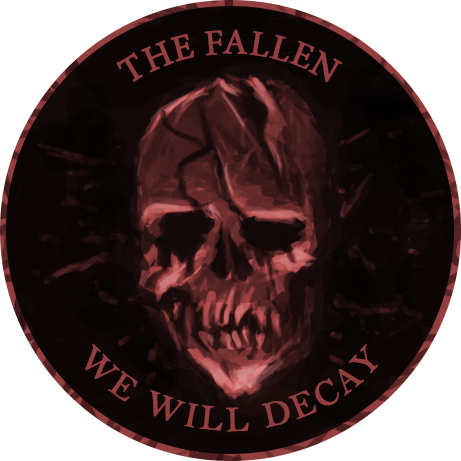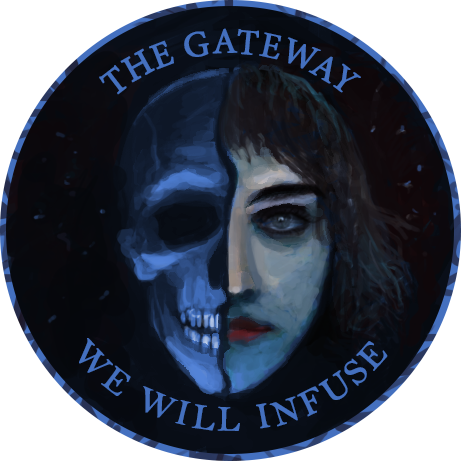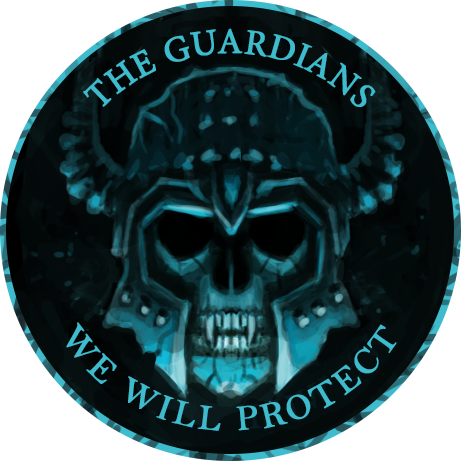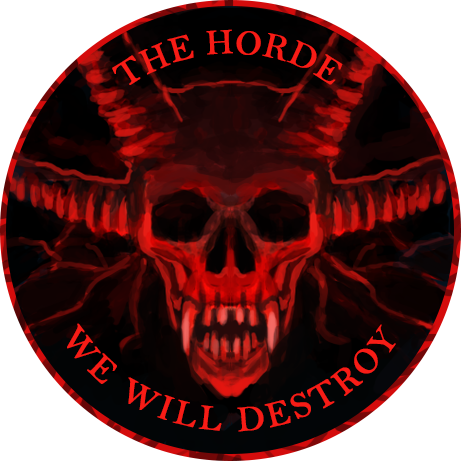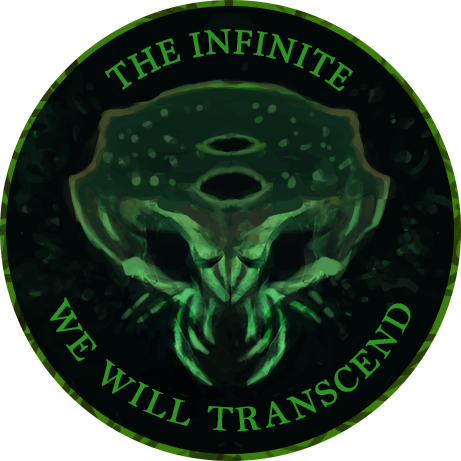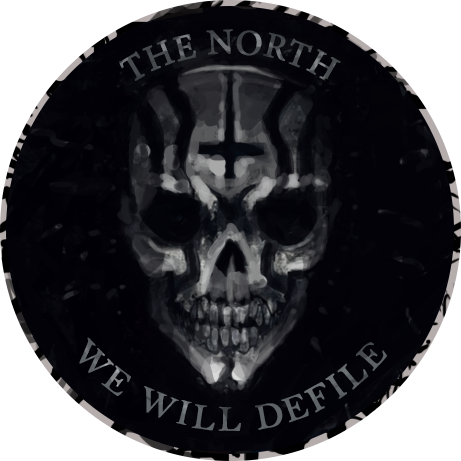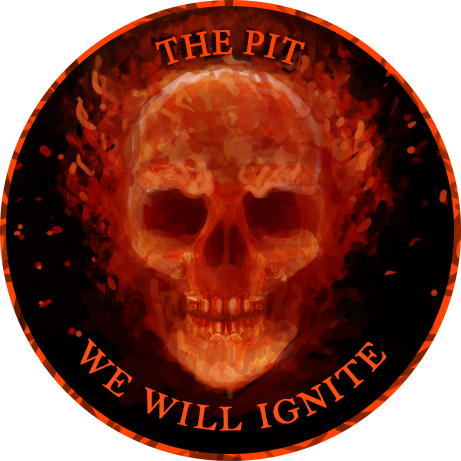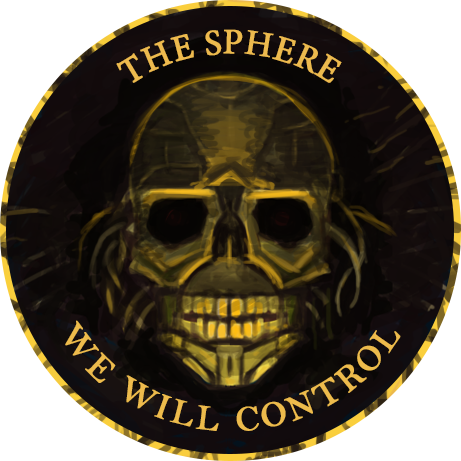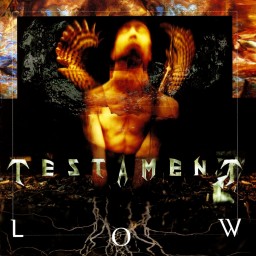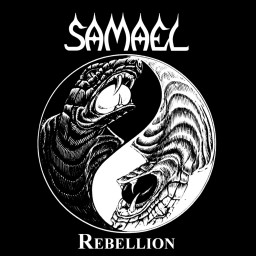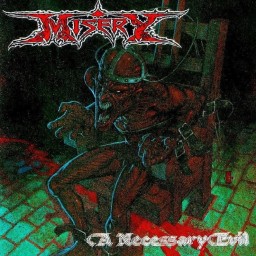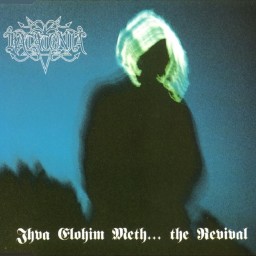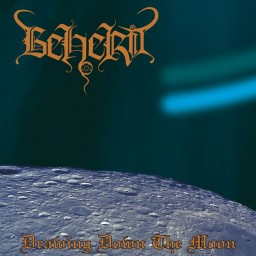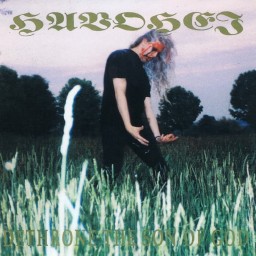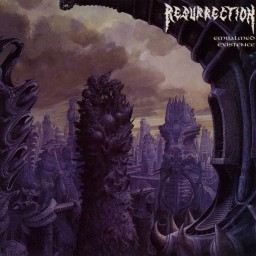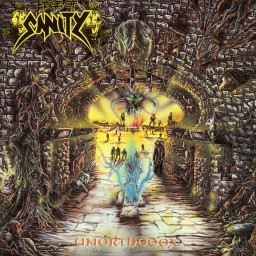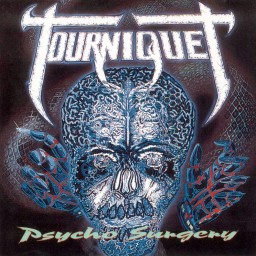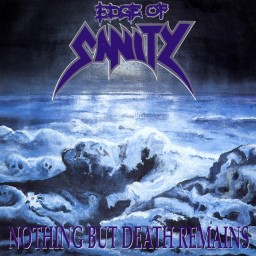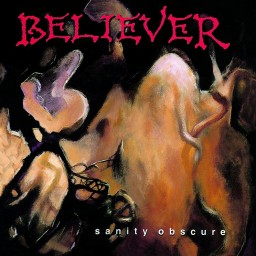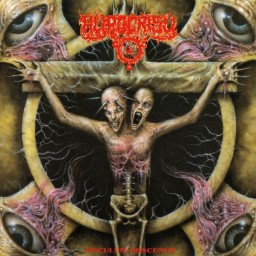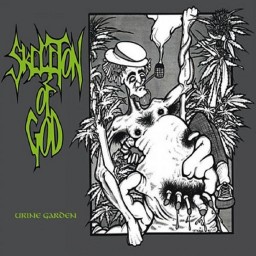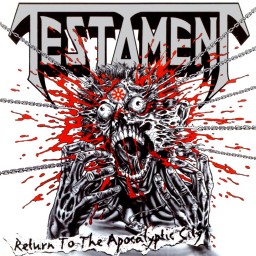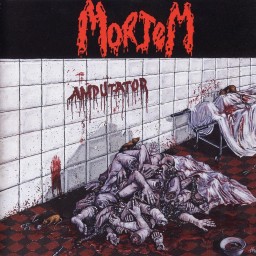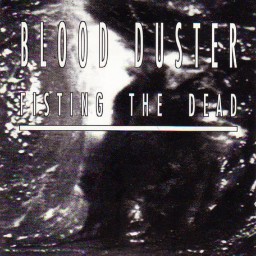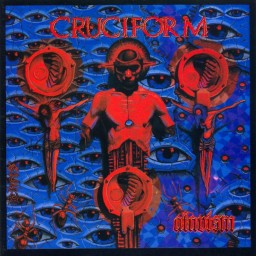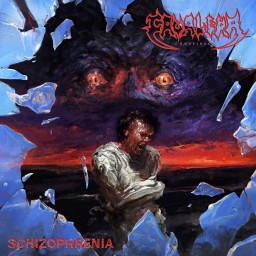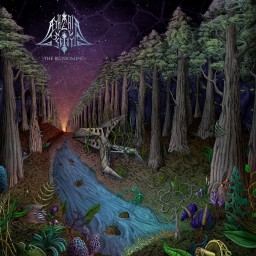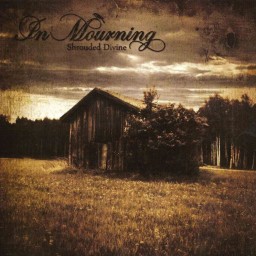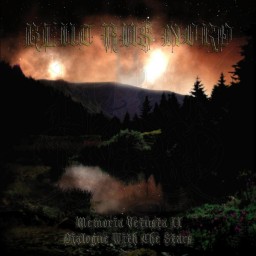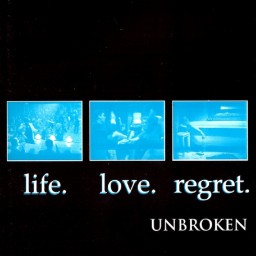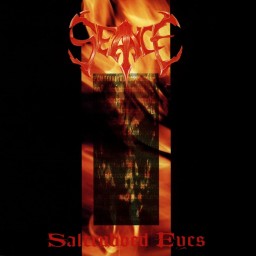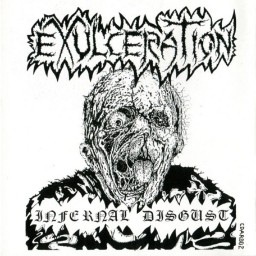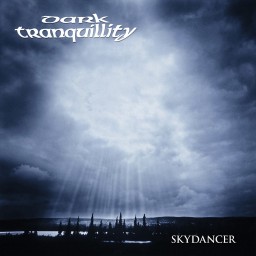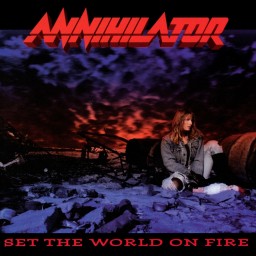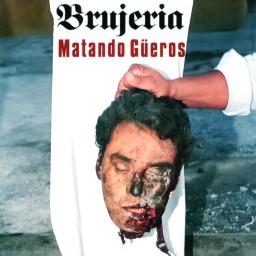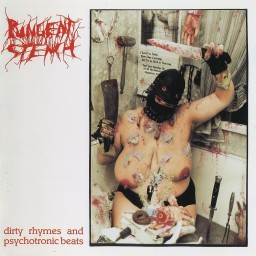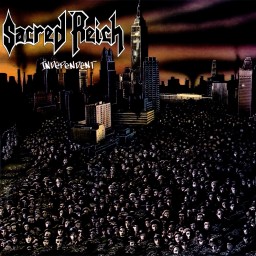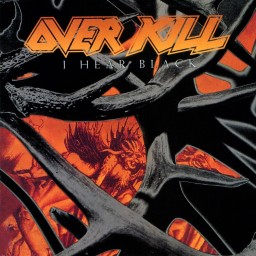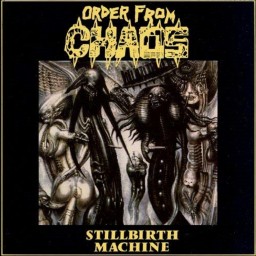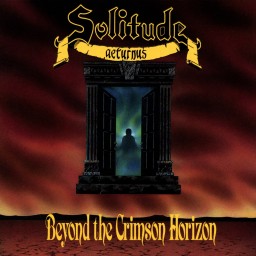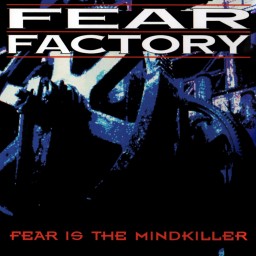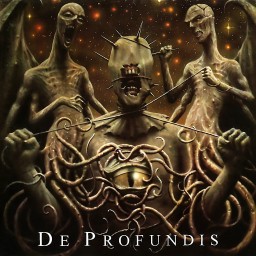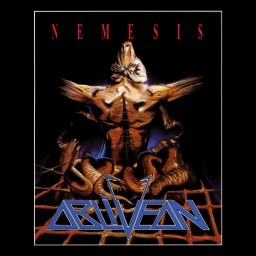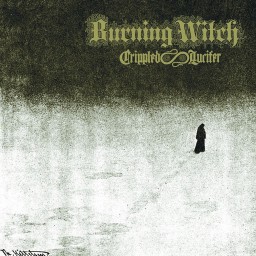Daniel's Reviews
Let's be honest with ourselves, US thrash metal legends Testament had gone off the boil a bit during the first half of the 1990's. While records like 1990's "Souls of Black" & 1992's "The Ritual" where serviceable enough metal albums, they weren't really at the same class as the bands more highly regarded 80's releases so I'd imagine that Testament were feeling a little bit of pressure to revive their heyday. The fact that "The Ritual" also saw them watering their sound down a touch with a stronger heavy metal influence probably didn't help & I feel that Testament's sixth full-length "Low" is probably a bit of a reaction to the negative impressions they would have received from some sections of the thrash metal community as it sees Testament returning with arguably their heaviest release to the time. The success of Pantera & the groove metal genre was clearly not lost on the Californians as "Low" sees Testament dropping most of the more accessible heavy metal leanings of "The Ritual", down-tuning their guitars further than ever before (generally a step or a step & a half) & throwing in deeper, almost death metal growls from time to time. Now, that probably sounds like it should offer me a fair bit of appeal on paper but the reality is that I haven't returned to "Low" since the mid-90's so there's gotta be something in that, right? The decades since have seen me largely forgetting about this record so it's time for a revisit to see where it sits in Testament's prestigious back catalogue to the time.
Let's get one thing straight right from the offset, "Low" is still first & foremost a thrash metal record so I don't think too many diehard fans would have been turned off by the stylistic changes the band had opted for on their sixth full-length. It's just that it "feels" a little more like a groove metal record at times & the reason for that is the extra down-tuning which takes a little bit of the shred out of the more exciting riffs in hope that the extra bottom-end will appeal to the mid-90's market a little more. I'm not sure whether it did or not but I can certainly say that I prefer Testament's thrashier & more electric sound personally. Chuck Billy's attempts at a more guttural delivery aren't too bad though & I know that was something that excited me the first time Ben played me his CD copy of "Low" shortly after release. These stylistic changes see many of the twelve tracks falling into the space between thrash & groove metal which is the reason why many people seem to tag "Low" as such (me included).
The inclusion of a ballad had become somewhat of a formality for Testament over the course of the previous three records & here we see them pulling it off with aplomb as the emotive "Trail of Tears" is one of the clear highlights of the album. It's interesting that Testament had also opted to include two instrumentals here too, both of which see them taking the listener into some fresh stylistic space to varying levels of success. I particularly enjoy the contribution of bass player Greg Christian on those numbers with him showcasing a clear Geezer Butler influence on both occasions. The centrepiece of any Testament album is generally reserved for the lead guitar parts though & "Low" is no exception with hired gun virtuoso James Murphy having filled the vacant position left by wonderful shredder Alex Skolnick & pulling it off with ease too. I've always been a huge fan of Murphy & he delivers one of his more restrained & diverse performances here, giving the song-writing exactly the sort of colour & highlights it required.
The main issue that holds "Low" back from becoming a more significant Testament record than their previous two though, is the lack of any classics in the tracklisting. The song-writing is gernally pretty decent with the band maintaining a level of class & professionalism throughout but there really aren't any songs that can compete with Testament's best work. My favourite numbers are clearly the before-mentioned "Trail of Tears" & the unusual instrumental track "Urotsukidôji" but neither seem to reach above a very solid level. There are also a couple of tracks that do very little for me & could probably have been culled in the obvious groove metal number "Legions (In Hiding)" & the rhythmic "Shades of War", both which are sorely lacking in the hooks department. I've never been the biggest Chuck Billy fan but he's always gonna struggle with his limited vocal prowess when the hooks aren't strong enough to carry him.
At the end of the day though, "Low" is another decent Testament record that should keep fans of the band on the hook. It's unlikely to draw in too much of a new fanbase though in my opinion. I'd suggest that it's a better record than "Souls of Black" was but would probably favour "The Ritual" over it just slightly. There's no question that it's a clear step down from the trio of 1980's albums that came during Testament's peak period though & the days when I would look forward to every new release from the band had clearly sailed past by this point.
For fans of Overkill, Annihilator & Anthrax.
Genres: Thrash Metal
Format: Album
Year: 1994
By 1995, Ben & I could count ourselves as being pretty big fans of Swiss black metallers Samael. We were both well across all three of Samael's albums to the time, all of which I consider to be essential listening for the black metal afficionado. I'd also gone so far as to secure myself dubbed copies of a couple of the band's early demo tapes through the tape trading scene in 1987's "Into the Infernal Storm of Evil" & 1988's "Medieval Prophecy", neither of which l'd say added much to my life if I'm being honest. But the point I'm trying to make is that there was a level of anticipation for Samael's next release after they'd improved on each & every recording to the time with 1994's "Ceremony of Opposites" third album being the finest work of the band's career still to this day. Coming off the back of such a successful effort, Ben & I went into 1995's stop-gap "Rebellion" E.P. with great confidence in the Swiss four-piece's ability to create a compelling musical soundscape so, when Ben brought home a CD copy of the brand-new E.P., we wasted no time in blasting it loudly from his bedroom stereo. Strangely though, I haven't given "Rebellion" much attention over the many years since which is a little bit telling. I wasn't able to remember exactly why though so I thought it was about time I gave it another crack.
"Rebellion" fits very much into your classic E.P. model as it's clearly a collection of disparate pieces that didn't fit into the full-length album concept. You get one brand new metal number in the title track, a couple of re-recordings of early works (see "After the Sepulture" & "Into the Pentagram"), a cover version of Alice Cooper's "I Love the Dead" & a few instrumental electro-industrial pieces, two of which are essentially the same with the exception of some German lyrics having been placed over the top of one. So, if you're looking for a cohesive & singular creative vision then you might want to look elsewhere. But what "Rebellion" does do successfully is create a transitional stepping-stone between the dark black metal of Samael's first three albums & their more industrially focused later material. It's here that you can first start to see Samael embracing the electronic component of the sound they're known for today although it's fair to say that it was still used a little more subtly which leaves the sound the band are pushing here in somewhat of a limbo between the two genres, not really feeling like either. It's mainly the use of spacey synthesizers that draws "Rebellion" into industrial metal territory although they're not over the top with a much greater emphasis being placed on that element for 1996's "Passage" album which pushed all the way out into fully-fledged symphonic metal territory.
The production job on "Rebellion" is thick & chunky & gives the material real clout, the riffs possessing a weight that comes more from the industrial metal side than the black metal one. The opening title track is the one that benefits the most from it with its groovy mid-paced riffage making it by far the most significant piece on the record. In fact, it's a little strange that it wasn't considered for inclusion on Samael's upcoming full-length albums to be honest as it's easily good enough & wouldn't have sounded out of place. The two re-recordings happen to be of my favourite tracks from each of Samael's first two albums which was a pleasant surprise but the reality is that neither can compete with the dark atmosphere of the originals, despite the heavier production techniques employed. I certainly enjoy both songs (particularly "After the Sepulture" which competes with "Rebellion" for the highlight of the E.P.) but neither added a lot to my life either to be fair. The rest of the E.P. feels more like filler than anything else in my opinion. I quite enjoy both versions of the six-minute electro-industrial piece "Static Journey" but can't see much reason for including both given that they're so similar to each other. Admittedly they do sound a little dated given the basic synthesized rhythms that have been employed. The three-minute outro piece utilizes the same creative platform but is unfortunately not as successful & I find it to be a little disappointing, as is the Alice Cooper cover version which feels more like a fairly accessible take on gothic metal than anything else & leaves me feeling like pressing the skip button a lot of the time although I've never been a skipper & likely never will be.
So, I feel that "Rebellion" was mildly successful in its quest to showcase a new sound that Samael would explore further across the remainder of their recording career but I would hardly say that it's essential listening for fans of the band. It's a professionally put together package & sounds bright & vibrant but I don't think it contains the depth that I enjoyed with Samael's first three albums.
For fans of Rotting Christ, The Kovenant & Moonspell.
Genres: Black Metal Industrial Metal
Format: EP
Year: 1995
In the early days of my death metal band Neuropath, the five of us thought we were kinda out on our own a lot of the time because the Australian extreme metal scene didn't really have anything like us at the time. Although there were other death metal bands scattered around the country, there didn't seem to be any that were dedicated to focusing on the more pure & overtly brutal end of the death metal spectrum in quite the same way that we were. My discovery of Brisbane five-piece Misery definitely threw a cat amongst the pigeons though as it showed us that it was possible for a local act to produce a full-length album that could compete with the Americans in terms of quality. They may not have fallen into that "brutal death metal" camp that we seemed to be so eagerly embraced by but their sound certainly sat right in the middle of the death metal pool in an unapologetic fashion that I found enormous appeal in. I hadn't heard of Misery prior to picking up their 1993 debut album "A Necessary Evil" on CD from my local record store shortly after release but they very quickly became a regular contributor to Neuropath gatherings. I can still vividly recall my first time seeing Misery play live at a tiny inner city venue actually, the five of us all stumbling out of the back of a bong smoke-filled van with Deicide music blaring. Misery were bloody good that night too & that experience would only work to drive our hunger to create a similar storyline with our own recording career. Since that time, I've always held "A Necessary Evil" in very high regard & have followed Misery across the course of their career, having headed back to their early 90's demo days & explored all of their subsequent albums & singles. I also think it would be fair to say that I experienced a sensation not unlike fanboyism when I discovered that Neuropath would be sharing the pages of the latest edition of "Devoured Death" 'zine with the band too & the pleasure I drew from that unexpected experience has led me to pull out Misery's debut for a long-overdue revisit.
The first thing worth mentioning in any discussion around "A Necessary Evil" is the excellent cover art which was likely the reason I first picked up the CD in the first place. The image & logo are extremely death metal & give the listener a pretty reasonable idea of what they can expect to hear inside. The ten tracks included were a collection of material that had been pulled together over the two-year period since the band's inception in 1991, six of which had appeared on Misery's early demo tapes "Sorting of the Insects" & "Astern Diabolus". In fact, the versions of "Septic Octopus" & "I Endure" (my personal favourite) that appear here were taken directly from the "Astern Diabolis" demo. The production job is thick & chunky & played a major role in highlighting all of the things that were great about Misery at the time. It also allowed them to be compared with the thriving international market because, unlike many Australian releases of the time, "A Necessary Evil" didn't sound inferior or demo-quality in any way. Front man Darren Goulding's vocal delivery was truly monstrous but didn't really sound like anyone else in particular either so, when combined with the weight of Misery's swampy down-tuned death metal riffage & eerie lead guitar melodics, Misery presented the listener sound that already owned its own unique identity.
One of the other strengths of "A Necessary Evil" was its consistency. There's not a dud to be found in this lot with the vast majority of the record sitting very much in the realm of the healthy second tier US death metal pool so it's a little disappointing that Misery never managed to break out of their home country a little more than they did. "Body Farm" (which was a re-recording of an early song from the "Sorting of the Insects" demo) sees things descending just a touch from the rest of the material but it's still an enjoyable inclusion nonetheless. The lack of any genuine death metal classics is probably the biggest reason that I never considered one of my more elite scores for "A Necessary Evil", despite the impact it may have had on me personally. Perhaps a touch more brutality might have seen that turning around as Misery generally steered clear of blast beats, focusing more on creating a graveyard atmosphere at mid-tempo which was a feat that they were no doubt very accomplished at.
I've really enjoyed my step back in time with this album this week. It's brought back some wonderful memories of an incredible time in my life which was full of musical discovery. Is "A Necessary Evil" worthy of its glorified position as an Aussie metal classic? Well, yeah... I think it is. I don't think it ever really reaches similar creative peaks to the Death's or Morbid Angel's of the world but the kudos it's earnt for opening up the local scene to the idea that an Aussie act can compete on an international level can't be denied. This record comes highly recommended from this ol' death metal tragic.
For fans of Innsmouth, Abramelin & Psychrist.
Genres: Death Metal
Format: Album
Year: 1993
I believe Swedish doom/death duo Katatonia's earliest work was another one that I picked up from Neuropath vocalist Mark Wangmann during the very early stages of the band with me having borrowed Mark's CD copy of "Jhva Elohim Meth... the Revival" & ripping it for my own private listening. This likely would have been towards the back end of 1993 & I hadn't heard of Katatonia before. I recall finding the material to show a fair bit of promise although the performances were a little more primitive than I'd generally accept. I don't think I was aware of the fact that this release was only ever intended to be a demo until a couple of years later but there was definitely enough quality there to see me giving "Jhva Elohim Meth... the Revival" a few listens & returning to it on the odd occasion over the next couple of years too. I'd pick up a dubbed copy of Katatonia's debut album "Dance of December Souls" from the tape trading scene shortly afterwards & would find a similar level of enjoyment there, although it's fair to say that I never fully committed to Katatonia until I picked up their "For Funerals to Come..." E.P. on CD in 1995. Katatonia would go on to much bigger & brighter things after that & have released records that mean a lot to me over the years. It's been decades since I last heard their initial "Jhva Elohim Meth... the Revival" release though so I thought I'd see how it sounds a good half a lifetime later.
"Jhva Elohim Meth... the Revival" offers five tracks across a seventeen-minute run time with the two pieces that bookend the release being high quality folk & ambient intro/outro style numbers. I really enjoy these two tracks & feel that they actually feel a lot more professional than some of the metal tunes included here which has me wondering if they might have been produced from outside of the band but I can't see any evidence of it online so perhaps not. The three metal songs traverse a variety of quality levels & you can easily see Katatonia defining their sound from track to track. By far the most significant piece is the seven minute "Without God" which was re-recorded for the "Dance of December Souls" album shortly afterwards. Here we see guitarist/bassist Anders Nyström's (Bloodbath/Bewitched/Diabolical Masquerade) talent for creating wonderfully engaging guitar melodies & harmonies in full effect even though he was still only seventeen years of age at the time. This element would become Katatonia's calling card in the coming years but it's surprising just how well defined it already was on this early version of "Without God" & I think I actually prefer this more primitive version over the re-recorded one that can be found on the debut full-length. The other two proper songs are less significant with "Palace of Frost" failing to capture me & containing a few fairly cringy moments, particularly the drastically out of key melodic guitar section. "The Northern Silence" fairs much better & is a reasonably enjoyable (yet still pretty inessential) example of the early Katatonia sound. Renkse's drumming isn't the most accomplished you'll ever hear on this record & is arguably the weak point of the release with his timing leaving a little bit to be desired at times. Interestingly, legendary metal producer/musician Dan Swanö (Edge of Sanity/Odyssey/Witherscape/Bloodbath/Infestdead/Karaboudjan/Pan.Thy.Monium/Ribspreader) contributes the keyboards & clean vocals on this record & is also responsible for the production job which is more than acceptable for a demo recording.
I don't believe I ever heard Katatonia's earlier rehearsal tapes, the first of which was reported to be a crude black metal affair. You can still easily hear the duo's black metal roots on "Jhva Elohim Meth... the Revival" too though, so much so that I'm tempted to label this E.P.'s sound as blackened doom/death as the black metal component seems to be significant enough to warrant it, particularly on "The Northern Silence". In fact, I'd probably go so far as to suggest that this release sounds like a combination of "Gothic"-period Paradise Lost & Rotting Christ's "Non serviam" sophomore album. The howled vocals of front man Jonas Renkse (later of Bloodbath & October Tide) definitely possess blackened elements while there are a number of genuine tremolo-picked black metal riffs included too. It's the doomier & more melodic parts of the E.P. that are the most engaging part of the release though & I'm not surprised that Katatonia ended up committing to that sound moving forwards.
To be open & transparent, I've never rated the "Dance of December Souls" album as highly as most doom/death fans seem to. I certainly find it to be pretty enjoyable but it's never seemed like anything particularly remarkable to me either & I actually don't see it as a noticeable step up from in quality from "Jhva Elohim Meth... the Revival". In fact, on the evidence of this revisit I'm going to suggest that I might even favour the E.P. just slightly over the debut album which I know will probably surprise a few people but neither record can compete with Katatonia's later material as far as I'm concerned. That's not to say that "Jhva Elohim Meth... the Revival" isn't worth a few listens for fans of the genre though because it certainly is. I'd just suggest keeping a little bit of perspective when going about it.
For fans of "Gothic"-era Paradise Lost, early Anathema & Rotting Christ's "Non serviam" album.
Genres: Doom Metal
Format: EP
Year: 1993
I've had a very long & stormy relationship with seminal Finnish black metal exponents Beherit's 1993's "Drawing Down The Moon" debut album over the years. It first came to my attention through the tape trading scene of the time (along with Beherit's three demo tapes & "Dawn of Satan's Millennium" E.P.) & I have to admit that I struggled with it initially. In fact, I can vividly recall conversations with Ben where we questioned the value of Beherit in general but recent months have seen me giving a second chance to many releases that I'd previously cast aside, often finding that their value became apparent with a little dedicated attention, & that's certainly been the case with this release which I now see as somewhat of an artistic triumph. Sure, Beherit may have some obvious failings that would have seen me tossing them in the "none of my business" bin with great vigor in my youth but closer attention has shown that the youngsters embraced those failings & have somehow managed to present them as positive characteristics of what is one of the more unique releases of its time.
Beherit's early demos & E.P.'s have gone on to be claimed as having been highly influential on the young war metal scene that had begun to boil away following the release of the Blasphemy records but its inaccurate to say that "Drawing Down The Moon" has much to do with war metal. This is more of an ultra-primitive take on black metal in my opinion with the lo-fi, demo-quality production job & loose performances seemingly having been intentionally embraced in order to contribute to a very deliberate result. There are certainly moments where the band take things too far & end up making a mess of things (see "Down There..." & "Werewolf, Semen & Blood") but when they manage to nail the sound they're going for it can honestly make for some of purest black metal you're likely to find. Many of these moments involve repetition & a more restrained tempo that lures the listener into almost a trance-like state with simple First Wave-inspired riffs working to give the music an authenticity that I find hard to resist as an old-school extreme metal fan.
The production job is obviously an obstacle for many metalheads but I find it to be kinda endearing these days to be honest. Nuclear Holocausto Vengeance's guitars are clearly too low in the mix but this failing is made up for by Black Jesus' huge bass sound that might as well be a heavily down-tuned guitar & when the two combine for a doomy Celtic Frost-influenced riff I find myself struggling not to jump on the train. I can easily see the influence that Beherit have had on countryment Archgoat in that respect actually. Nuclear Holocausto Vengeance's whispery vocal delivery is also a major talking point for some punters & there's no doubt that they're too high in the mix but I don't agree that they sound childish or immature. To my ears, they sound positively evil most of the time & are one of the highlights of the album. There's an unbridled insanity to them that really gets to me & it suits the primitive instrumentation really well. Are the performances loose? Sure, but it's not as extreme as it's made out to be. I mean, these guys were almost virtuosos compared to early Sodom & no one seems to mind with records like "In the Sign of Evil", do they?
At the end of the day, a record like "Drawing Down The Moon" will always be divisive but I get the impression that it was always intended to be. It was made for a limited demographic of hardcore extreme metal fans that are obsessed with the more underground side of the scene & I'm pleased to see that I can still play in that space after all these years. The ritualistic aspect of the album offers me genuine appeal too with the ambient interludes (like the wonderful "Nuclear Girl" which I utterly adore) playing a major role in the overall package & the artistic component being more important than any level of precision or structure. The brilliant closer "Lord of Shadows & Goldenwood" is a clear example of this & sits amongst my very favourite metal tracks of the period with its trio of different atmospheres combining to create a transcendent ending to a record that can be described as much more of an "experience" than your average black metal release. Love it or hate it, every fan of underground black metal owes it to themselves to at least have an awareness of "Drawing Down The Moon".
For fans of Archgoat, Von & Mystifier.
Genres: Black Metal
Format: Album
Year: 1993
When I recently took a detailed look at the 1993 releases I needed to fill historical rating gaps for, the debut album from New York black metallers Havohej was definitely one of the less appealing records to appear in the list. It was the release that first made me aware of the US solo act shortly after it was released but I could vaguely recall finding it to be a pretty flat experience at the time & I honestly haven't felt the need to revisit it since, despite having investigated a few of Havohej's subsequent releases over the years. "Dethrone the Son of God" seems to have developed somewhat of a cult following over the years though so I thought it was worth taking another look at it, if only to satisfy my obsessive urge for completism.
Havohej (or "Jehovah" backwards) is the solo project of Profanatica front man & drummer Paul Ledney (also formerly of US death metal legends Incantation) who handles all of the instruments on this release with the help of Profanatica guitarist John Gelso. The cover artwork is the first obstacle that you'll need to overcome as it challenges for the worst in black metal history. The music contained within is certainly better than the artwork would have you believe but is still nothing to write home about. It's a very short album with its fifteen tracks racing past in just 28 minutes. There's a strong death metal influence evident with some songs containing what are essentially death metal riffs but Ledney's blackened snarl invariably sees me wanting to tie the record to black metal nonetheless. The level of musicianship isn't fantastic but then I don't think that's the point of a release like this one which seems to be targeted more at your kvlt black metal elitist demographic than anyone else. In fact, the beginning & end of some of the tracks leave the impression of a tape recorder having been triggered to start recording a track in mid performance, not unlike some of Darkthrone's recording techniques at the time.
"Dethrone the Son of God" kicks off in reasonable fashion with the first few tracks all being more than acceptable but the quality levels start to become pretty inconsistent from that point on. I wouldn't say that any of the metal numbers are terrible but there are four or five that sound pretty flat & do very little for me. I enjoy the sections of the album that see Havohej slowing things down a bit to create an eerie atmosphere that's similar to Mayhem's more down-tempo passages like the legendary climax of "Freezing Moon". The big elephant in the room is the closing title track though which sees Ledney screaming a succession of immature blasphemic obscenities in acapella, a task that leaves him sounding incredibly naive & silly, even for a still very young US black metal scene. It kinda sums up Havohej's debut really as there's not an ounce of sophistication about it. It's all very obvious & purely surface level which leaves the listener with the option to simply take it or leave it. Personally, I think I'm gonna have to go with the latter but can appreciate the dark atmosphere of the stronger material (see "Raping of Angels Part II" & album highlight "Fucking of Sacred Assholes" which literally only uses a single note but manages to draw me in through some well placed rhythmic variations).
For fans of Profanatica, Demoncy & Bestial Summoning.
Genres: Black Metal
Format: Album
Year: 1993
I picked up the 1993 debut album from Florida death metallers Resurrection very early in my tape trading days & it made a pretty big impact on me too, triggering many return visits over the years & a general fondness that's seen me often wondering why these guys didn't amount to more than they did. "Embalmed Existence" is a rip-roaring extreme metal record of high-quality with Resurrection presenting a very professional & appealing sound that's benefitted from a trademark Scott Burns production job at the legendary Morrisound Studios as well as a typically dark & eerie Dan Seagrave album cover. So, why didn't it manage to achieve a stronger level of notoriety than it did? Well, I think some of that comes down to the inclusion of many spoken-word interludes that I personally find to add something to the album but many people simply find to be annoying. I can't understand it to be honest. I think they give "Embalmed Existence" its own unique character.
While Resurrection may not be the most brutal of US death metal bands, there's a cohesion to their attack that easily makes up for the lack of blast-beats. I particularly enjoy the contribution of drummer Alex Marquez (Solstice/Cephalic Carnage/Demolition Hammer/Malevolent Creation) who ties the instrumentation together with great precision, giving some of the simpler sections a little more meat than they might otherwise have had. Resurrection's weakness is definitely in the vocal department though with front man Paul Degoyler's whispery death growls lacking a bit of depth. While revisiting the album this week I got the distinct feeling that Degoyler was one of the guitarists because it seemed like all of his vocal parts were strategically positioned over some pretty simple riff structures, giving me the impression that he wasn't the most skilled of multi-taskers. I was surprised to discover later on that Paul is a dedicated grunter as it seemed so obvious to me but I guess I shouldn't make assumptions.
"Embalmed Existence" kicks off in stellar fashion with opener "Disembodied" being a classic example of the Florida death metal sound. My personal favourite "Pure Be Damned" comes a lot later in the piece & sees Resurrection playing in spaces that only the very top tier of the genre have any right to be. The remainder of the tracklisting is generally very solid with only the seriously misguided cover version of KISS' "War Machine" that ends the record being a throwaway. Resurrection tend to take two very clearly defined directions here. On the one hand you have the more brutal influence of Malevolent Creation which is probably where I see most of the stronger moments residing & on the other you have the more crushing & slower tempo power chords riffs of Obituary. Perhaps those influences are a little too blatant at times but I'm a big fan of both bands & there are enough unique elements to Resurrection's sound to give them their own identity regardless, particularly those interesting interludes which never overstay their welcome.
This revisit has once again proven to me that Resurrection were very unlucky not to receive a lot more attention than they did. Perhaps the slightly weaker vocal contribution is the main reason for that? it's hard to say but they were a more than capable band with a classy sound that fits right inside my wheelhouse & was probably a bit of an influence of the early Neuropath material too given how much time I spent with "Embalmed Existence". I think most of our The Horde members should find a fair bit to like here.
For fans of Malevolent Creation, Obituary & Morta Skuld.
Genres: Death Metal
Format: Album
Year: 1993
I found myself in an interesting position after revisiting the 1991 "Nothing But Death Remains" debut album from Swedish death metallers Edge of Sanity last week. It probably shouldn't have been all that much of a surprise given my well-documented struggles with the more melodic end of the extreme metal spectrum but I discovered that I slightly preferred Edge of Sanity's rawer & more traditional first-up death metal effort over their more highly celebrated classics like 1994's "Purgatory Afterglow" & 1996's "Crimson", a position that puts me largely out on my own from what I've seen over the years. This left me wondering whether perhaps some of the albums in between might challenge for top honours though as I'd certainly been across all of the Edge of Sanity back catalogue during my tape trading days & remember those releases quite fondly too. One of my old tape traders (who also happened to be the bassist in Aussie doom/death band Elysium who I spent some time with) held the Swedes up as his very favourite band so I was always kept abreast of where Edge of Sanity were at, sometimes to the extent of force-feeding me if I'm being honest. Perhaps this has something to do with me not having returned to 1992's generally well received "Unorthodox" sophomore album since the late 1990's but it's time to fill the glaring gap in my ratings for what has gone on to become one of the more important bands in the whole Swedish death metal phenomenon.
Rightly or wrongly, "Nothing But Death Remains" hadn't exactly set the world on fire from a critical or commercial point of view but Edge of Sanity didn't lose hope, returning to the same studio they'd become comfortable with during the recording of their debut full-length (i.e. Montezuma Recordings in Stockholm) to knock out their second full-length effort. This time though, it seems that the band &/or executive producer Börje Forsberg (the father of black metal legend Quorthon) decided that Edge of Sanity would be best served by giving in to the lure of the popular BOSS HM-2 Heavy Metal pedal worshipping sound that bands like Entombed & Dismember had made Sweden's calling card over the previous couple of years. Personally, I can't say that I've ever favoured that sound over the one popularized by the Americans but I can't deny that it works for Edge of Sanity here, giving them a brighter & more vibrant sound that better highlights the slightly more melodic & expansive arrangements we find on "Unorthodox".
Once again, I feel that Dan Swanö's powerful death growls are probably the best thing about this record as he regularly reminds me of Morbid Angel's Dave Vincent with his tone losing none of its menace despite maintaining clear intelligibility. Where "Nothing But Death Remains" generally traversed some fairly commonly taken creative routes though, "Unorthodox" sees Edge of Sanity starting to take a few risks by expanding their repertoire & even hinting at the progressive edge of the two "Crimson" releases. Does it all work? Well, yeah it does but, by the same account, it rarely finds me reaching for superlatives. There's no doubt that "Unorthodox" is a slightly more consistent record than the debut was with none of the ambitious fourteen tracks failing to offer some level of appeal but I can't say that too many of them really get my blood pumping either. It's only really the one-off attempt at doom/death in excellent closer "When All Is Said" that sees me placing Edge of Sanity into that second tier space with the rest of the album simply coming across as a decent example of the signature Swedish death metal sound more than anything else. The generous 57-minute run time was perhaps a little ambitious for a conventional death metal release too & I think Edge of Sanity might have needed to have taken the progressive component further still if they were to maintain my full attention for that sort of period.
Despite its musical direction moving a little further away from my wheelhouse than that of "Nothing But Death Remains", I'd still suggest that "Unorthodox" has a slight advantage over its elder sibling as its class & consistency see me placing just above the debut in the band's overall pecking order. As scandalous as this might sound, this also sees it sitting above Edge of Sanity's more highly regarded mid-90's albums too which likely has more to do with my struggles with the melodic death metal subgenre than it is anything to do with the quality contained on each release. This does beg the question as to where the Swede's 1993 third album "The Spectral Sorrows" sits in the grand scheme of things & I intend to answer that question in the coming weeks. Until then though, I can't see "Unorthodox" disappointing too many fans of the classic Swedish death metal sound but I'd be surprised to see it topping too many charts all the same.
For fans of Dismember, Entombed & Bloodbath.
Genres: Death Metal
Format: Album
Year: 1992
Unlike Believer's 1990 "Sanity Obscure" album which I reviewed a couple of days ago, I definitely know that I first discovered Los Angeles thrash metallers Tourniquet through a copy of their 1991 sophomore album "Psycho Surgery" which Ben had borrowed from one of his Christian mates who was trying to prove to him that Christians could be metal too. I think it's fair to say that I was skeptical about the whole concept initially but, by the time I'd gotten through my first spin of this high-quality thrash metal record, I had to admit to myself that I'd been converted (to Tourniquet, not to religious fairy tales). I don't think I told Ben at the time because, you know... I was a dark & evil death metal master & all... but the experience saw me secretly seeking out Tourniquet's equally impressive debut album "Stop The Bleeding" & following them on to their third record "Pathogenic Ocular Dissonance" which wasn't too bad either. I've even gone so far as to investigate a couple of their releases from the 21st Century since my return to metal in 2009 & this all stems from the impression left that day in Ben's bedroom all those years ago. I've actually returned to Tourniquet's first two albums quite often over the years but have never given any of Tourniquet's releases the dedicated attention required to justify a Metal Academy review until now & I've been interested to see how "Psycho Surgery" would stack up in the modern day.
It's always baffled me that Tourniquet didn't manage to break out of the underground a little more as they were clearly a very talented bunch of dudes & you can easily hear that on "Psycho Surgery". I can only guess that it's the religious aspect that's turned people off a bit & I can understand that as the lyrics do get a bit preachy at times. Thankfully I'm able to switch that element off because I've never been one to place too much emphasis on lyrical themes. The musicianship is the real highlight here though with the lead guitar work of Gary Lenaire being the standout performance. This dude has some major chops & knows just how to use them too. In fact, he could stand toe to toe with some of the elite performers of his craft if I'm being honest & never fails to impress me. The vocals of Guy Ritter are pretty cool too as he has quite a versatile range of tones & deliveries, sometimes sounding a fair bit like Overkill's Bobby Ellsworth & then running very close to Dave Mustaine territory during some of the spoken word-ish sections. The production job can sound a little wishy washy during some parts of the album but the instrumentation maintains a level of class throughout & never sits still for too long with Tourniquet showing off a wide array of influences.
"Psycho Surgery" kicks off in classic thrash metal form with a couple of mosh pit friendly numbers but things get a little more interesting when progressive metal outing "Viento Borrascoso (Devastating Wind)" enters the fold. It's a sound that Tourniquet do very well & would explore further on records like "Microscopic View of a Telescopic Realm" & "Antiseptic Bloodbath" later in their career. "Broken Chromosomes" also explores that more progressive direction & does a reasonable job at it too. Rap metal experiment "Spineless" is probably the track that stands out the most in the tracklisting & not in a good way either but monster doom metal closer "Officium Defunctorum" more than makes up for that creative failure & challenges the wonderfully catchy thrash metal anthem "Dysfunctional Domicile" for my favourite song on the album. The forty minute run time is well suited to Tourniquet's sound & I think the plethora of different sounds keeps things really interesting with even "Spineless" conatining a couple of great riffs.
Don't let the whole Christian thing turn you off because Tourniquet are worthy of any diehard thrasher's attention in my opinion & if you do happen to be a Christian then "Psycho Surgery" should be considered to be essential listening. I'm not across their entire back catalogue but "Psycho Surgery" is one of the better releases from the five that I've heard with all of them being at least worth a few listens. It's been a while since I heard it now but I think the debut "Stop the Bleeding" might just slightly pip "Psycho Surgery" for my favourite Tourniquet release overall but there's very little between their first three & I'm yet to experience a Tourniquet release that was likely to disappoint.
For fans of Deliverance, Believer & Megadeth.
Genres: Thrash Metal
Format: Album
Year: 1991
Swedish melodic death metal establishment Edge of Sanity first came to my attention through metal radio programming back in the very early 1990's off the back of their 1991 debut album "Nothing But Death Remains" which is a very different prospect to the one that saw them completely blowing up off the back of their 1996 fifth album "Crimson". You see, Edge of Sanity began life in much the same way as many of their Swedish peers i.e. as a far more conventional death metal band that took its earliest steps over ground that was already well trodden. Not being much of melodeath fan myself, I have to admit that this idea holds a stronger appeal for me than it may to many others so this week's revisit of "Nothing But Death Remains" has only proven something that I already strongly suspected. Yep, I actually prefer Edge of Sanity's rawer early works over their widely celebrated mid-1990's material.
While "Nothing But Death Remains" may have a fairly tinny production job by today's standards, it wasn't anything out of the ordinary for a young band at the time & there was already a class to Edge of Sanity's compositions that defied this record's status as an early 90's debut. The boys hadn't adopted the signature BOSS HM-2 pedal driven Entombed/Dismember wall of sound as yet but they certainly sounded like they had already spent a bit of time paying their dues as the musicianship is all solid & the song-writing offers enough variation to keep me interested. The tracklisting is quite consistent with only the disappointing second track "Human Aberration" failing to meet an acceptable standard. I really enjoy the use of guitar harmonies but the Dave Vincent-ish vocals of band leader Dan Swanö are probably the highlight of the record for me personally. There's a graveyard atmosphere that Edge of Sanity rarely achieved again here &, despite the fact that "Nothing But Death Remains" is hardly essential listening for the average death metal listener, it's far from the misfire that many fans of the Swede's later material would have you believe it is.
For fans of Bloodbath, Uncanny & early Hypocrisy.
Genres: Death Metal
Format: Album
Year: 1991
There's a bit of a gap in my ability to remember how I first came across Pennsylvania technical thrash metallers Believer. I've always been of the belief that they were brought to my attention by my brother Ben after he borrowed a copy of Believer's 1990 sophomore album "Sanity Obscure" from one of his Christian mates but Ben has recently denied having any exposure to the band so I suspect that I might have picked up a dubbed copy from one of the kids in the year above me at school. Regardless of how it came about though, I remember being pleasantly surprised by what I heard as the idea of a Christian extreme metal band seemed like somewhat of a contradiction but Believer appeared to be a seriously capable outfit. The experience would see me going back & checking out Believer's 1989 debut album "Extraction From Mortality" & following them with interest in the future although I think that appeal tailed off a bit after their 2009 comeback album "Gabriel" failed to connect with me & I haven't as yet given their 2011 follow-up an airing. There's little doubt that "Sanity Obscure" was some of the band's best material though so please join me as I revisit it for the first time since the 1990's.
The first thing you'll notice about "Sanity Obscure" is the savage, metal-as-fuck production job which really appeals to me. I simply adore the ultra-distorted guitar tone which gives the riffs additional incisiveness & weight. It reminds me very much of Exodus & Exhorder, both whose guitar tones play a major role in their appeal for me personally. The song-writing on the early part of the album is super-complex though too, making Believer a band that's genuinely deserving of the tech thrash tag. That complexity does tail off a little as the album progresses though so I feel that a dual tag with conventional thrash metal is probably more accurate on this occasion. The vocals & instrumentation both showcase a clear Coroner influence which can't be a bad thing but the album is noticeably top-heavy so the quality level starts to become very inconsistent across the back end of the record. "Dies Irae (Day of Wrath)" sees Believer incorporating orchestral instrumentation & classical female vocals in what can only be described as a highly ambitious attempt at symphonic thrash metal. It doesn't work in my opinion which is a real shame after such a strong A side that included a genuine progressive/technical thrash classic in the brilliant "Nonpoint". Things get worse though with closing number "Like A Song" being a terribly misguided attempt at a heavy metal/US power metal anthem that sees guitarist & front man Kurt Bachman making a real meal of some more emotive vocals. These two creative failures leave an unfortunate stain on what is otherwise a very high-quality tech thrash effort.
Look, there's still a lot to like about "Sanity Obscure" & I can definitely see why I found it so appealing in the first place. It's just that it makes for a far better source for playlist inclusions than a full album as there's such a drastic disparity in quality between those two duds & the remainder of the album which is all very solid indeed. Unfortunately, "Sanity Obscure" isn't even available on Spotify so I don't even have the option to include the better songs in our playlists available to me. Sadly, I feel like this was a missed opportunity for Believer as all of the components were here to create a timeless record but they've somehow managed to let their own ambitions get the better of them. Still... anyone who harbors any doubts about the validity of the Christian metal band need only listen to a large chunk of this record & I can assure you that you'll have your position swiftly turned around. Sure... there are some preachy lyrics on offer here but I find that I can easily ignore them & get with listening to a particularly classy & technically accomplished group of young thrashers.
For fans of Coroner, Extol & Seventh Angel.
Genres: Thrash Metal
Format: Album
Year: 1990
I first became exposed to Swedish death metallers Hypocrisy through their 1992 debut album "Penetralia" after noticing a cassette copy floating around Neuropath front man Mark Wangmann's house in early 1993 & I have to admit that I quite enjoyed it too although I wouldn't suggest that it's essential listening by any means. My recent revisit to that particular record has proven that I probably gave it a little more attention than it deserved at the time though because I seemed to recall most of the song-writing pretty vividly. I'd subsequently pick up a dubbed copy of Hypocrisy's sophomore album "Osculum Obscenum" through one of my metal connections shortly afterwards & found it to offer a very similar level of reward although I can't say that I can recall this material anywhere near as much as "Penetralia" which is an indicator that I moved on from it fairly quickly. This is perhaps not all that surprising when you consider that "Osculum Obscenum" is basically more of the same brand of meat-&-potatoes death metal that Hypocrisy had dished up on their earlier effort with the limited technical skills that tainted my view of "Penetralia" still being on full display here. The riff construction is pretty standard for a third tier death metal player while the drumming & lead guitar work showcase a level of naivety that the band was still yet to overcome. I find the poorly executed blast beats to be a bit of a distraction as poor old Lars Szöke simply can't keep them in time for more than a couple of bars so they end up resembling a train crash by the end of those sections due to his lack of endurance. There's no doubt that Hypocrisy knew a good hook when they heard one though so there's still plenty to enjoy here.
Although "Osculum Obscenum" is of a pretty similar standard to "Penetralia", I do tend to favour the debut just slightly over it. "Penetralia" definitely contained a couple more highlight tracks than "Osculum Obscenum" but it also fell flat a little more regularly so there's a bit of give & take there. At the end of the day though, the fact that I can recall the songs from "Penetralia" more vividly than those from their follow-up is the telling factor in me placing "Osculum Obscenum" slightly behind "Penetralia" in respect to the overall Hypocrisy back catalogue. The band would go on to produce better records than both of these crude early works but I'd suggest that both are still worth a few spins for the any self-respecting Swedish death metal devotee.
For fans of Bloodbath, Dismember & early Edge of Sanity.
Genres: Death Metal
Format: Album
Year: 1993
Colorado four-piece Skeleton of God are another band that I sought out back in my tape trading days in my quest for ever more extreme forms of metal with their debut E.P. "Urine Garden" receiving quite a few plays back in the day. The Skeleton of God sound could be described as a quite technical, avant-garde & progressive take on the brutal death metal model although these guys were clearly still finding their sound so some tracks are definitely more unusual than others. You can't deny the ambition from such a young group of dudes but I do have to admit that I prefer the conventional material like highlight track "10 Second Infinity" over the more intentionally weird inclusions (see the opening title track for example). The way Skeleton of God construct their riffs is quite unique though & this attribute gives the band their edge, along with the gutteral vocals of guitarist Jeff Kahn which are very effective. It's a real shame that the production job isn't adequate for this type of release though as I feel it may have picked up more of an underground reputation with a cleaner & more powerful sound.
For fans of Human Remains, Wicked Innocence & Embrionic Death.
Genres: Death Metal
Format: EP
Year: 1993
The early Finnish black metal scene was a particularly dark place to be back in the early 1990's. For one reason or another they had a habit of producing some of the most raw & evil examples of the black metal type known to man at the time with artists like Beherit, Archgoat, Belial, The Lord Diabolus & Black Crucifixion all pushing a darker & more blasphemous sound than that of their neighbours. Impaled Nazarene fit into that environment very comfortably & arguably could only have come about because of the activity around them. I first picked up a copy of their debut album "Tol Cormpt Norz Norz Norz..." in a tiny record store called Rock 'n' Roll Warehouse which was located in the famous George Street Cinema complex in the Sydney CBD very shortly after it was released. I had a close relationship with the guy that worked behind the counter & he generally kept me abreast of releases that would fit my taste profile. On this occasion he implored me to purchase Impaled Nazarene's debut album, saying that it was one of the most savage example of the black metal sound he'd yet had the pleasure of hearing. I eagerly complied with his request & ran home to find that he wasn't wrong. It was hard to take the Fins seriously though as it seemed on the surface that much of their image was tongue-in-cheek & that element always saw me struggling to fully commit, despite seeing a lot of positives in the Impaled Nazarene sound. It wouldn't stop me from purchasing their next two full-lengths on release though & I've continued to keep abreast of each subsequent record over the years, if only to see my curiosity being kept in check.
The week saw me giving "Tol Cormpt Norz Norz Norz..." a few spins for the first time in years & finding that I could still recall almost the entire run time which is a strong sign that I gave it thrashing back in the day. Looking back now, I find it hard to understand why Impaled Nazarene weren't dragged in under the war metal banner that so many of their countrymen were because there's as much war metal on offer as their is genuine black metal in my opinion. You've got the gratuitous Satanic references, the grindcore influence, the death metal production... Hell, you've even got a three minute orgy of demonic bestiality & if that's not a war metal trait then I don't know what is. If you put aside the blatant attempts to stir up attention through obviously antagonistic lyrical content & imagery though, there's actually a lot to like about the band's sound. While it may be very basic, it's also super-tight with the performances all being spot on. I particularly enjoy the solid drumming of Kimmo Luttinen as they offer an impressive amount of power & control while the vocals of his brother Mika are viciously confronting.
"Tol Cormpt Norz Norz Norz..." kicks off in very strong form but unfortunately the B side sees the quality levels dropping a touch. That flaw wasn't enough to see my dropping my rating below an impressive four star rating though & I feel that the Impaled Nazarene sound is probably a little better suited to my current taste profile than it was the one I was still building as a seventeen year old when I first encountered it. This has left me wondering whether I might see some of their other early releases like "Ugra-Karma" achieving similar scores so a revisit is certainly on the cards there. If you're able to accept a black metal release that doesn't take itself overly seriously yet still manages to conjure up a bestial blasphemy of blasting blackened war metal then you may want to give "Tol Cormpt Norz Norz Norz..." a few spins. Just don't expect to find anything terribly deep as the Impaled Nazarene model is similar to the classic punk rock aesthetic they're influenced by i.e. it's simple, in-your-face & a little immature & snotty.
For fans of Sadistik Exekution, Impiety & Belial.
Genres: Black Metal
Format: Album
Year: 1993
Ben & I had been pretty big fans of Californian thrash metallers Testament for a good four years by the time this six-track live release hit the streets in 1993. I'd enjoyed all of their records up until that time but the last couple had seen the impressive quality levels of the first three Testament albums dipping a touch so I wouldn't say that I was busting to get my hands on their next record but I still found myself parting ways with my hard-earned cash for this little live release as soon as I noticed it's ball-tearing cover artwork sitting on the record store shelf. "Return to the Apocalyptic City" offers four live tracks which were recorded at a recent show at the Los Angeles Palladium as well as a studio cut from the sessions for 1988's "The New Order" album & a shortened version of "Return To Serenity" from Testament's latest record "The Ritual". All of this material is entertaining, particularly the live versions of "Over the Wall", "So Many Lies" & "Disciples of the Watch". My favourite inclusion is the studio cut "Reign of Terror" though which is the fastest & thrashiest number on offer & had been popping up in Testament live sets since way back in 1984 when they were still known as Legacy. The performances are all strong, particularly the guitar solos of Glen Alvelais & Alex Skolnick which are a real highlight. The production is also much better than the awful sound quality Testament had to contend with on their only previous live release in 1987's "Live at Eindhoven" E.P. which gives "Return to the Apocalyptic City" a clear edge over that record in my opinion. This one should definitely interest most Bay Area thrash fans, even if its format makes it fairly inessential in the grand scheme of things.
For fans of Metallica, Exodus & Megadeth.
Genres: Thrash Metal
Format: EP
Year: 1993
I picked up the 1993 "Amputator" debut album from Russian death metal outfit Mortem through the mid-90's tape trading scene &, looking back now, probably gave it a little more attention than it warranted at the time, mainly because I was thoroughly obsessed with the early brutal death metal sound & had a tendency to lap up anything that fell into that space. The first few albums from US death metal legends Cannibal Corpse were a pretty major influence on the early work of my own death metal band Neuropath & it's very obvious that they were on Mortem too as "Amputator" is nothing short of complete plagiarism in many regards. The production job is pretty awful but the song-writing is extremely consistent which allows the music to overcome that flaw, at least for those of us that were used to listening to ultra-raw demos at the time. The musicianship is pretty good with all of the arrangements being reasonably accomplished for such a young band but it's the ultra-deep death growls that are the highlight of this super-underground record that's largely been lost in time. The shredding guitar solos are also one of the better elements & I'd suggest showcase a bit of a Deicide influence too. I've enjoyed this revisit but I can't say that "Amputator" should be essential listening. I'd also suggest that the brutal death metal tags are a little ambitious as this sounds more like conventional death metal to my ears, at least by today's standards.
For fans of Cannibal Corpse, Mortal Decay & Disastrous Murmur.
Genres: Death Metal
Format: Album
Year: 1993
The debut release from a legendary Melbourne band that I saw play live many times back in the 1990's. It includes 25 tracks across 19 minutes, eight of them being hilarious intros that have been borrowed from D grade horror films like "Bad Taste". This music is not meant to be taken too seriously but boy is it entertaining. Early Blood Duster offered a well-constructed & produced sound that took the blast-beat driven goregrind of early Carcass & combined it with the groovy death 'n' roll riffs of post-1991 Pungent Stench. The use of double-kick in the blast-beats leaves a little bit to be desired by today's standards but we didn't notice it all that much back in the day. The song-titles & lyrics are as over the top as you'd expect from a goregrind act with ditties like "Vulgar Taste (Of A Rotten Cunt)", "Knee Deep in Menstrual Blood (The Bleeding Bitch Returns)" & "Blood Fart" being some of the better ones. Throw this one on a drunken party with your mates & press the "repeat" button cause it's all over in a flash.
For fans of Macabre, Pungent Stench & early Carcass.
Genres: Grindcore
Format: EP
Year: 1993
The early 90's was a terrifying time to be a classic thrash band. By 1993, the grunge scene had unceremoniously stripped thrash metal's audience with some of the remainder being carried away by the death/black metal boom so many of the major bands were all fighting for a smaller market share. Pantera had also hit on a key niche of the market with their fresh new groove metal sound that had taken the metal scene by storm &, in order to survive in that environment, many artists simply chose to jump onboard the grunge or groove metal bandwagons with mixed results it has to be said. Big Four member Anthrax was one such act with their 1993 sixth album "Sound of White Noise" seeing the five-piece transitioning away from their thrash metal roots for a sound that took an each-way bet on the grunge & groove metal movements. Many fans would immediately jump off the train but the inclusion of talented Armored Saint front man John Bush in place of classic Anthrax singer Joey Belladonna had certainly peaked my interest, particularly given that I was a huge fan of Bush's work on the Saint's 1991 fourth album "Symbol of Salvation". Ben would purchase "Sound of White Noise" on CD upon release & we'd both spend some time adjusting to the new Anthrax direction. Interestingly, I recall both of us really enjoying it & nothing much has changed there either.
Although "Sound of White Noise" is generally regarded as a groove metal release, I would argue that there's actually a lot more alternative metal here, easily enough for a dual primary tag with thrash metal being the lone secondary influence. To say that "Sound of White Noise" sounds like a different band to the one we heard on classic thrash records like "Among The Living" or "Spreading the Disease" is not entirely accurate though. You can still clearly hear a lot of the techniques the band had made their calling cards but they're used more sporadically here. Tracks like "Potters Field", "Invisible", "C₁₁ H₁₇ N₂ O₂ S Na" & "Burst" would have comfortably fit on earlier Anthrax records though so this isn't a completely foreign environment for extreme metal fans. Bush's more masculine vocals are certainly a little different from Belladonna's but not to the point that you couldn't easily imagine him singing the earlier classics pretty successfully. I personally gravitate more to the Bush tone anyway so this change was always gonna appeal to me. He doesn't nail everything in front of him here but, after a few listens, I can't imagine too many punters feeling like he'd rained on the Anthrax parade.
The eleven-song tracklisting doesn't tend to unveil all of its charms upon first listen & repeat listens definitely see it opening up progressively more. There are a couple of genuine Anthrax classics on show if you're open to discovering them. The obvious highlight of the record is the anthemic single "Only" which possesses an absolute belter of a chorus hook & is the best reference for the skill set that Bush brought to the band you're likely to find. High-octave, energetic alternative thrasher "C₁₁ H₁₇ N₂ O₂ S Na" is also an underrated gem & I've found that it's dug its talons into my flesh to ever greater depths over the last week. The rest of the tracklisting ranges from pretty decent to very solid with only the lackluster alternative metal number "Hy Pro Glo" failing to offer me any level of appeal. Perhaps there aren't enough tier one inclusions to see "Sound of White Noise" pressing for Album Of The Year honors but it certainly had enough about it for Ben & I to remember it very fondly amongst our childhood memories.
So, where does "Sound of White Noise" sit in the prestigious Anthrax back catalogue then? Well, it might surprise a few people to hear that I actually rate it somewhere in the middle rather than towards the bottom rungs. I'd comfortably take it over the legendary New York thrash metal establishment's 1984 debut album "Fistful of Metal" & also feel that it's a more consistently interesting record than 1988's "State of Euphoria" fourth album which was more acceptable than it was impressive. Many people seem to try to tarnish this record with a harshly-worded groove metal brush but that's not a true reflection of the quality of the song-writing or the professionalism in the performances. Anthrax were a high-quality metal act who have produced another high-quality metal record here in my opinion but there's no doubt that it requires thrash fans to go into it with an open mind.
For fans of Acid Drinkers, Prong, Sepultura.
Genres: Alternative Metal Groove Metal
Format: Album
Year: 1993
The only proper release from Sydney-based doom/death metal exponents Cruciform came to my attention at a time that I regard as being amongst the more exciting in my life to date. 1993 saw me forming the first iteration of my own death metal band Neuropath (still under our early moniker of Coprophagia) with four younger kids from the local area & we had every right to think that we might be the only metalheads in the entire Northern Beaches region that were clued up on the thriving death metal phenomenon that had taken off in the underground metal scene a couple of years earlier. One day one of us came back from the local record store Sandy's Music with a copy of the "Atavism" CD & shared it with the rest of the band who all enjoyed its filthy brand of death metal-infused doom. The music was simple enough for us to compare to our own early works but sophisticated enough to exude a strong pedigree in an underground scene that was currently thriving off the back of the tape trading concept. It wouldn't be long before we'd learn that Cruciform were actually located fairly close in proximity to us &, even more impressive, were also one of the senior players in the Sydney extreme metal scene at the time, being signed to the infamous Warhead Records label that was responsible for several key releases in the annuls of Australian metal history & would go on to release Neuropath's 1996 "Desert of Excruciation" demo too. This added additional appeal to the CD & would see us analyzing "Atavism" in greater detail. Opening track "Sanctuary" would become somewhat of a band favourite & we'd go about covering that song at all of our early live shows. At one Lewisham Hotel gig in 1994 we'd be approached by the sound guy after our set, only to find that we had just played a Cruciform cover to the band's new vocalist/keyboardist Simon Gruer which was terribly exciting. Shortly afterwards we'd realize that the long-haired gentleman behind the counter at Sandy's Music that had sold many of the local kids their copies of "Atavism" was in fact guitarist Leon Kelly too & I'd build up somewhat of a familiarity with him over the next couple of years. I wouldn't go so far as to say that he was an idol but I certainly looked up to him & listened to what he said with great interest.
Cruciform would go on to develop & mature very quickly after the release of "Atavism", culminating in the amazing "Paradox" demo tape in 1995 which saw them poised to break out of the local scene with a new deal with legendary English extreme metal label Earache Records in the works. We were heading to all of the band's live shows (well... the ones we could get in to as most of the other band members were still under the age of 18) which had become immeasurably more epic off the back of Gruer's inclusion & the strength of the new material. But just when Cruciform's light was about to shine at its brightest, the band spilt up & were lost from the Sydney scene, seemingly overnight. They'd reform many years later in 2012 & are still playing shows now but have not released any new recorded material that I'm aware of up until now. That's obviously quite a story but was "Atavism" really as good as my young ears thought it was at the time? Or was I simply dazzled by the idea of some local brothers in arms that were older than me & had achieved things that I was still yet to attempt? Well, I think the answer is a bit of both looking at it with modern-day ears.
"Atavism" was a six song release that we actually regarded as being an E.P. back in the day given its relatively short 32-minute duration. It opens with a lengthy three-minute neoclassical darkwave synthesizer piece that hasn't stood the test of time very well & sounds fairly cheesy these days. The remaining five pieces are made up of extreme metal tunes that had all become staples of the Cruciform live sets & are all worth hearing too, some more than others though it has to be said. The production job has a lovely layer of underground dirt caked on it that gives the music some additional authenticity while the musicianship was still fairly basic at this time with several examples of timing issues being plainly visible in the recordings that were clearly produced under tight financial constraints.
The early Cruciform sound is often touted as sitting somewhere between the doom/death sound that had taken the global scene by storm off the back of the Peaceville Three a couple of years earlier & a more conventional death metal one. You can certainly see why on the evidence here but the doom/death component plays a much stronger role than the death metal one so I don't think there's much reason for a dual tagging personally. "Reduced to Dust" is really the only straight-up death metal tune included with "Proboscis" being more of a hybrid & I'd suggest that those two tracks are probably the least impressive of the five proper songs anyway. Those pieces often remind me of My Dying Bride's early death metal efforts actually. The doomier material is where the real guts of Cruciform's notoriety was formed though with the two songs that bookend the release ("Sanctuary" & "I, to the Heavens Shall Lift My Eyes") being the clear standouts in my opinion. The band was still a four-piece at the time but utilized a three-pronged vocal attack that adds a great deal of interest to their sound. I particularly enjoy the ultra-deep death growl that reminds me of "Symphonies of Sickness" era Carcass although the occasional use of a higher register approach comes across as a little weak & gurgly.
Early Cruciform already possessed an uncanny knack for melody, particularly for such a young band. The way they allow their better compositions to build over time showed a good understanding of dynamics, even if the technical capabilities of the various band members still seemed to be a little immature at the time. Listening back now, I can easily pick up some sections of tracks like "Proboscis" & "I, to the Heavens Shall Lift My Eyes" that have been reworked into some of the more brilliant parts of the "Paradox" demo that I still regard as one of the finest I've ever heard to this day. Unfortunately though, I don't think any of these pieces compare all that well to the two epic numbers that make up that incredibly underappreciated release & this leaves "Atavism" as very much the entree to the "Paradox" main course. It's hard for me to think of it as anything else after all the years of solitary bedroom worship for Cruciform's later material but "Atavism" is still worth seeking out for early doom/death enthusiasts as there weren't too many artists exploring these creative avenues at the time. "Paradox" would see Cruciform pushing a sound that was wwaayy ahead of its time & could well have had a major impact on the global scene if it was given the right production & exposure in my opinion. Unfortunately, it wasn't to be though & we're left with only these limited recording to enjoy which in many ways pre-empted my own musical journey with Neuropath.
For fans of Hearse, Sorrow & Asphyx.
Genres: Doom Metal
Format: Album
Year: 1993
I have to admit that the trend to re-record previously released material with modern-day technology is not one that I'm particularly fond of. Rarely does it see the desired results being achieved by bringing something fresh & different to an album that's generally already got its own loyal following so the idea of the Cavalera brothers having another crack at Sepultura's highly regarded 1987 sophomore album "Schizophrenia" wasn't one that immediately filled me with anticipation. Their recent re-recordings of Sepultura's more primitive earlier releases "Bestial Devastation" & "Morbid Visions" had certainly been reasonably successful but "Schizophrenia" was a much more sophisticated record & I struggled to see a reason to want to give it a new coat of paint when the old one was still in pretty good nick. You see, I've always been a big fan of the original version of "Schizophrenia". I picked it up on cassette when I was still a youngster, shortly after becoming completely infatuated with Sepultura's classic 1989 "Beneath the Remains" album. It was an immediate hit in my household & has received many revisits over the years so I can't say that I wasn't pleased that Ben gave me a reason to investigate the revitalized version by nominating it as this month's "The Pit" clan feature release. I just wasn't expecting to be wowed in the process.
The band that the Cavalera brothers assembled for the task is a little different to the one they went with for their previous re-recorded efforts. Max's son Igor Cavalera Jr. (Go Ahead & Die) is still there on bass guitar but the lead guitar slot that was previously being filled by Gruesome/Possessed/Proscriptor McGovern's Apsû axeman Daniel Gonzalez is now being owned by Igor Jr.'s former Healing Magic & Lody Kong bandmate Travis Stone (Noisem/Pig Destroyer) on this occasion. I have to say that I haven't been majorly impressed with Stone's work here though as he lacks the polish of the very capable Andreas Kisser which leaves the guitar solos seeming like less of an emphatic statement than they were on the original.
So... how is the production job that is largely the reason for conducting this exercise in the first place then? Weeeellll... it certainly sounds a lot cleaner, brighter & more in your face than the original did but it's not without its issues either. The drenching of Max's vocals & Igor's toms in reverb was a strange decision & does tend to annoy me a little if I'm being honest. I'd suggest that Max's vocals simply aren't as strong any more so the decision was made to hide his deficiencies a little through studio trickery but it hasn't really worked because it's still as plain as day if you ask me & I much prefer his gruntier contribution on the original version. That's not to say that I get nothing out of this glossier model though because that's not the reality at all. As most people will probably do as some point, I decided to whack on the 1987 version immediately after my third spin of the revamped one in order to see the differences & they were far more stark than I realised previously. In fact, the original version sounds a lot like a demo recording in that context & I was surprised by just how deficient it appeared to be in retrospect because I've never had too much of a problem with it in the past. Perhaps there was a good reason that Cavalera's decided to give another crack after all then.
The tracklisting is unsurprisingly impeccable with no weak numbers being included. Opener "From the Past Comes the Storms" is still my pick of the bunch but I feel that the lengthy instrumental "Inquisition Symphony" also really shines here & gives it a run for its money. "To The Wall", "Escape to the Void" & "Septic Schizo" are perhaps not quite as classic in this environment as I remember them being back in the day which is interesting. The two intros/interludes have been recreated in slightly different forms but I wouldn't say that either are as effective as they once were so perhaps they would have been off simply remastering the originals. The inclusion of an Igor Jr. penned new original in "Nightmares of Delirium" is probably the most significant point of interest here but I'd suggest that it's also the weaker of the proper metal songs on offer, even if it's still worth a few listens. So overall we have more losses than wins but it's nothing drastic as the album is still highly entertaining, mainly because "Schizophrenia" is a total riff-fest & nothing has changed there.
Was it really worth the effort to re-record this old classic? Perhaps. I mean it certainly contains more energy & vitality than the original mix did but I'd have to argue that I still enjoy the 1987 version a little more. I can't deny that I had a good ol' headbang to this one on the way to & from work on Friday though as this is some pretty premium thrash metal after all. It's probably not terribly essential if you already own a copy of Sepultura's version from back in the day though. Let sleeping dogs lie I say. So, why have I awarded the release such a good score you may ask? Well, I choose to treat every release on its own merit when creating reviews & this is still a fine example of South American thrash in my opinion so it'd be inaccurate for me to suggest otherwise with a reduced rating simply because I like it a touch less than Sepultura's version.
For fans of Sepultura, Slayer & Sodom.
Genres: Thrash Metal
Format: Album
Year: 2024
It's great to see a young band growing with each release & that's exactly what we've seen with French progressive black metallers Æthĕrĭa Conscĭentĭa. I struggled to get into their 2018 debut album "Tales From Hydhradh" when I first came across the band however their 2021 follow-up "Corrupted Pillars of Vanity" showed promise & we're now seeing that promise coming to fruition with their latest release "The Blossoming" which is a genuinely intriguing listen. Æthĕrĭa Conscĭentĭa's black metal roots would appear to be almost secondary concern at this point & it wouldn't surprise me if they were done away with altogether in the quest for ever more unique musical explorations in the future. Their modern sound uses black metal more as a platform for them to experiment over in some fairly unusual ways although I would say that they ever quite dive into the waters of the truly avant-garde on "The Blossoming", potentially only because of just how well they've integrated the experimental components into their arrangements which leaves the quirkier components still sounding reasonably fluid. The use of saxophone is beautifully executed & brings to mind fellow experimental black metallers White Ward. Not all of it works so well but the failures are comfortably outweighed by the successes.
It's worth noting that "The Blossoming" does have an unusual characteristic in that I feel all three of the tracks on the A side are noticeably weaker than those on the B side which is where the real meat is located. This has a tendency to leave an initial impression that isn't exactly accurate of the release as a whole & it took me a couple of listens to realise that this was a more significant outing than "Corrupted Pillars of Vanity" was. The track that most grabbed me was also the one that contained the least black metal in "Daimu Kadasdra Ko Antall" which utilizes psychedelic bongos & gothic atmospherics that bring to mind Tiamat's classic "Wildhoney" album to create a beautifully lush soundscape. "Endless Cycle" & the title track (particularly the second half of it) are the pick of the black metal-based material.
This sort of release is often a little too weird for me to score as highly as I have here but Æthĕrĭa Conscĭentĭa have managed to pull it off with a professionalism & maturity that I've been unable to resist. I wouldn't suggest that this is a record for black metal fans only either as there's a lot more to it than that, even in the extreme metal sections. The album contains a few doomier sections that make up some of the more effective parts of the record while the vocals aren't exactly your typical black metal shriek either, often veering off into deeper territories usually traversed only by the death metal brigade. If I could provide any advice to the band, I'd suggest that they focus a little more on the psychedelic angles that I enjoy so much but that's probably just a reflection of my personal taste as "The Blossoming" is still a very solid release in its own right.
For fans of Alchemist, White Ward & Pan.Thy.Monium.
Genres: Black Metal Progressive Metal
Format: Album
Year: 2024
Sweden's In Mourning would make my acquaintance fairly early on in their recording career off the back of this month's The Horde feature release "Shrouded Divine" which represents their initial foray into the full-length album format. The record had been floating around for roughly a year by the time I revitalized my interest in metal & began progressively exploring every new extreme metal release of any significance, at which time I discovered that In Mourning had a bit about them which would ultimately prove to be enough to see me investigating each of In Mourning's five subsequent albums as they came to fruition. There have certainly been some that appealed to me more than others as I wasn't much of a fan of 2010's "Monolith" sophomore record yet regard its 2012 follow-up "The Weight of Oceans" as one of the better melodic death metal records I've ever heard but there are few that would deny the class that these artists exude in the way they go about things. Interestingly though, I don't think I've returned to "Shrouded Divine" in the fifteen years since I first wrapped my ears around it & I was wondering whether that might be a telling fact going into this week's revisit. Let's find out.
If I'm being completely transparent then I'll have to admit that "Shrouded Divine" took me a bit of time to warm up to on this occasion, perhaps due to the fact that my first listen came immediately after the very strong Blut aus Nord The North clan feature release "Memoria Vetusta II: Dialogue With the Stars" which resides much further within my wheelhouse. In Mourning simply sounded a little lightweight in comparison but subsequent listens saw the album starting to open up a bit for me & by the end of my third spin I could clearly see the appeal in this professionally produced & executed extreme metal record. Despite the consistent labelling of In Mourning as a melodic death metal band, "Shrouded Divine" doesn't offer much in the way of death metal at all to be honest. In fact, I'd suggest that the ties with the melodeath sound are tenuous at best given that the tag is intended to draw together releases that share a complex harmony-driven sound. In Mourning's early sound was much more in line with the progressive metal of Opeth & if you take away the very deep & gutteral vocals of guitarist Tobias Netzell (formerly of Swedish doom/death act October Tide & progressive rock/metal outfit Thenighttimeproject) then you'll find that In Mourning have a lot more in common with Dream Theater than they do At The Gates so the album is best suited to an "extreme progressive metal" tag in my opinion. I feel that the tendency to want to find a death metal subgenre to associate with the album is mainly to differentiate it from the Fates Warnings & Queensryches more than it is to throw In Mourning in with the Dark Tranquillitys & In Flames'.
In Mourning have pulled their sound together very nicely when you consider that this was their first studio effort. The musicianship is all of a high quality & there's an impressive level of cohesion that sees the sum of the various parts amounting to significantly more than they may have in isolation. There are a couple of elements that don't sit as well with me though to be fair. The occasional use of blast-beats from drummer Christian Netzell is largely nullified by his drum sound which leaves them sounding like he's tapping away on a matchbox. The use of screamier vocals for a bit of variety was a nice idea in theory but these ones sound like they would have fit very comfortably on a generic deathcore record. Unlike Ben though, I actually think the clean vocals are a nice touch & provide some welcome variation. Despite being a progressive band, In Mourning aren't the most complex example you'll find & they don't take too many other risks either with many off their riffs sounding fairly familiar. You won't struggle to recall the signature Opeth octave chords or the rhythmic bottom-string djent riffs that were so popular at the time while listening to "Shrouded Divine". Thankfully though, In Mourning pull it all off with aplomb in what is generally a very tight, finely-honed debut effort.
Most progressive metal fans should find the tracklisting on "Shrouded Divine" to be pretty consistent once they've given the record the time to sink its teeth in a bit. In fact, I don't think there's a weak track included as such. There aren't really enough genuine highlights to see me feeling like returning to the album all that often though either & that's perhaps the record's biggest detractor for me personally. It certainly sounds very pleasant & quite accessible for an extreme metal release. It doesn't get my blood pumping all that often though & that's the difference between a release that draws me back time & time again & one that I maintain a fondness for without ever really feeling the urge to return to. "Amnesia", "By Others Considered" & (my personal favourite) closer "Past October Skies (The Black Lodge Revisited)" are my pick of the bunch & are all very solid examples of their type but I'd question whether any of them should be granted access into my Hall of Metal Glory for all eternity. They're certainly nothing to be scoffed at though & I can very easily see why a record like this one might appeal to my brother much more than it might to my blackened soul.
At the end of the day, "Shrouded Divine" was a pretty good way to kick off a recording career as it provided a solid platform for In Mourning to build & improve on over the many years since. It's perhaps been relegated to the reserve bench a bit since I heard 2012's "The Weight of Oceans" a few years later but I don't think many fans of extreme progressive metal will struggle to find the appeal in a record like this one & I'd suggest that it still sits in the top half of the band's back catalogue overall.
For fans of Barren Earth, In Vain & Persefone.
Genres: Death Metal Progressive Metal
Format: Album
Year: 2008
My earliest experiences with French black metal stars Blut aus Nord came through the tape trading scene of the mid-to-late 1990’s when I became exposed to their first two albums, both of which I really enjoyed. My self-imposed hiatus from the metal scene for pretty much the entirety of the 2000’s saw me almost completely forgetting about this band though & it wasn’t until Ben encouraged me to investigate their classic 2003 fourth album “The Work Which Transforms God” upon my return to metal in 2009 that my passion for Blut aus Nord was reignited & boy it was an exhilarating experience too. That record possesses a purity of darkness that few in the black metal scene can touch & it affected me on a deep enough level to see me flogging the album for months to come. Since that time though, I’ve found Blut aus Nord to be a little hit & miss with some of their releases falling a little flat & others reaching the higher stratospheres of the black metal air space. 2009’s seventh album “Memoria Vetusta II: Dialogue With The Stars” has always been one that I’ve taken very positively though, even if it perhaps doesn’t sit amongst my favourite Blut aus Nord records overall. I’ve returned to it several times over the years but have never afforded it the dedicated attention required for a well-informed review until now. Let’s take a look at what it’s all about.
Blut aus Nord releases inevitably possess their own unique characters & “Memoria Vetusta II” is no different in that regard. It contains some really big positives that drive its appeal but it also presents us with a couple of weaknesses that prevent the album from becoming the true classic it seems to have the potential to be on the surface. Unlike some of Blut aus Nord’s more experimental or avant-garde efforts, “Memoria Vetusta II” is noticeably more accessible & is unquestionably an atmospheric black metal record. It’s a lot more about producing ethereal soundscapes than it is about battering or intimidating the listener with its tone creating a calmer & more contemplative view of the world than a record like “The Work Which Transforms God” which was significantly darker. There’s a strong focus on melody here with the stunning guitar riffs combining with some subtly incorporated, almost angelic synthesizers to wonderful effect. In fact, the keyboard work sometimes reminds me of German ambient producer Gas with its soft, organic timbre beautifully intertwining with the guitar work to produce some quite vivid visuals. This is the real strength of “Memoria Vetusta II” as there’s an undeniable class about the way Vindsval creates his guitar parts & I find this element of the record to be infinitely impressive.
Unfortunately, there are a couple of things that detract a little from the strength of those components though. Firstly, the programmed drums sound weak & obviously artificial which goes against the more organic nature of the rest of the instrumentation. There are certainly those more industrially-tinged Blut aus Nord releases where the drum machine plays an intrinsic role in the atmosphere but here I find that it lacks the required cohesion with the rest of the instrumentation, a flaw that is only further highlighted by the fact that the bass guitar is so low in the mix that it’s almost redundant. Similarly, Vindsval’s grim black metal vocals reside quite a bit further back in the mix than I’d ideally like to see them sitting. This technique works really well for many of your more lo-fi & noisy black metal artists but here I find myself consistently wishing they were a little further towards the front so that they could compliment the clear strength in the guitar work. Sadly, this was not to be & I’ll have to take “Memoria Vetusta II” for what it is. Let’s not sit here dwelling on what-if’s though because this is still a damn fine black metal record in its own right.
The nine-song tracklisting is a wonderfully consistent collection of material that flows very nicely together, despite containing a few interesting deviations from the standard atmospheric black metal model. My pick of the bunch is actually the ambient/dungeon synth intro piece “Acceptance (Aske)” which puts me into a lovely warm & meditative state before the black metal assault firmly jolts me to attention. The more traditional black metal numbers are all very solid with "....The Meditant (Dialogue With the Stars)" & "Antithesis of the Flesh (...And Then Arises a New Essence)" being the most significant compositions in my opinion. The well-executed clean folk guitar piece “Translucent Body of Air (Sutta Anapanasati)“ works very well to break up the album while instrumental closer “Elevation” is also worth mentioning as it's comfortably my favourite of the metal tracks. I love the way that it manages to transcend the black metal genre through the use of repetitive, melodic motifs which wash over the listener. It’s a stunning way to finish what was already a highly rewarding hour of black metal.
Look, perhaps “Memoria Vetusta II: Dialogue With The Stars” isn’t the career-defining masterpiece that so many black metal fans seem to claim it as these days but it is a damn fine record nonetheless & one that I can’t see disappointing too many extreme metalheads, at least once they’ve given it a few spins & accepted the initially distracting drum programming. I have to admit that this was an obstacle for me on each occasion that I’ve revisited “Memoria Vetusta II” over the years but those feelings of hesitation inevitably fade once I became reacquainted with the obvious quality in the guitar hooks. There are three or four Blut aus Nord releases that I’d reach for before “Memoria Vetusta II” when I feel like a fix of high-class French black metal but there’s no doubt that it’s a record of substance that needs to be heard in an underground scene that’s so chock full of followers. These guys clearly fit into the category of leaders & their influence on not only their local scene but the international one is beyond question.
For fans of The Ruins of Beverast, Akhlys & The Eye.
Genres: Black Metal
Format: Album
Year: 2009
I’ve been meaning to get around to checking out San Diego metalcore outfit Unbroken for a long time now. I don’t mind me a bit of 1990’s metalcore on occasion & these guys seem to be known as one of the more prominent examples of that sound so I had a funny feeling that they might be something I’d dig. Their 1993 debut album “Ritual” seems to receive generally positive feedback but it’s Unbroken’s classic 1994 sophomore album “Life. Love. Regret.” that receives the bulk of the attention so let’s see if it warrants the lofty praise that is inevitably heaped upon it then.
Unlike many of the more widely celebrated metalcore releases, “Life. Love. Regret.” doesn’t try to reinvent the wheel, instead taking a tried & tested direction that lives or dies by its attitude & authenticity. Thankfully though, it has both of those attributes in spades which has no doubt pleased the hardcore purists to no end. The relatively short 35 minute album doesn’t try to be anything that any good hardcore band shouldn't aspire to be. The production job is fairly raw but is still chunky & heavy while the performances are left pretty loose with no attempt having been made to clean up any timing concerns. Those things simply don’t matter all that much when it comes to hardcore music. It’s a more about the visceral urges they inspire in the listener & a general lack of fucks being given.
From a musical point of view, “Life. Love. Regret.” might as well be a guidebook for new players on what 90’s metalcore was all about really. Simple yet crunchy power chord-driven riffs? CHECK! Mosh-worthy breakdowns? CHECK! Angry & aggressive screamed vocals? CHECK! Occasional post-hardcore experimentation? CHECK! In saying that though, there’s an honesty & integrity about this music that places it above the sum of those tick boxes. There’s a purity in Unbroken’s sound that I find to be really easy to buy into. It didn’t quite sink in on first listen but I found myself liking this record more & more with each revisit & that has a lot to do with its consistency as the quality of the song-writing as it rarely dips below the really solid platform that’s set right from the offset with only “Blanket” feeling a little less essential even if it still generally enjoyable.
The two elements that drive this album are its clear points of strength. The riffs are the first of those components with Unbroken seemingly rewriting the manual on metallic hardcore crunch. I can easily imagine how intense this band would have been live because these anger-fuelled guitar parts seem to have been born for mosh pit mayhem. As a guitar nut myself, I found it hard not to buy into Unbroken’s selling point in that regard as I live for the sort of amplifier reverberation they possess in spades, even if the riffs are kinda basic a lot of the time & aren’t exactly performed with precision. The other major highlight can be found in the vocals of front man Dave Claibourn who steers away from that gurgly hardcore tone that I’ve always found to be a little weak by giving himself a little more of a natural sound. It gives his stories of life on the streets some added believability & he does a fantastic job at drawing the listener in through sheer fire & vitriol. In fact, it’s hard to deny that he’s the major calling card for the album overall & I’d suggest that he’d have to one of the more appealing hardcore vocalists out there.
A four-star rating was always on the cards from the first second I pressed play on “Life. Love. Regret.” to be honest as it stays predominantly at that level throughout its nine songs. While “Blanket” may have seen the quality curve dipping just a touch, the biggest talking point for the album comes in the form of a total game-changer that sits right at the end of the tracklisting. The nine-minute epic “Curtain” is nothing short of a devastating, tension-building beast of a track that I’d suggest should rightfully sit amongst the absolute elite examples of the metalcore genre. Its use of repetition & dynamics to draw the listener in from both a physical & cerebral perspective is astounding & I’ve found it hard not to allow my passion for this one piece to dictate my feelings on the holistic package to tell you the truth. I genuinely feel sorry for people that don't have the patience to connect with a piece like this one.
Despite the lengthy classic that dominates the B side though, I still can’t see “Life. Love. Regret.” as a classic release. Essential? Oh definitely, particularly if you’re a die-hard metalcore or hardcore fan. But I don’t think the majority of the album is different enough for it to command the loftier scores in my ratings system. Perhaps I’ve simply come to it a little late in the game but I can’t help but feel that “Life. Love. Regret.” doesn’t really do anything terribly different to a lot of metalcore release. Perhaps Unbroken are the source of all of that in the first place though? I dunno but what I can say is that I’ve rarely heard a better example of this type of music than this record & I can easily see why those metalheads with a stronger affiliation with the metalcore genre than I would tend to gush over it as I’ve been surprised at just how much I've enjoyed the experience.
For fans of Rorschach, Starkweather & Racetraitor.
Genres: Metalcore
Format: Album
Year: 1994
If you follow my reviews fairly religiously then you're probably aware that I recently reinvigorated my deep passion for Swedish death metallers Seance through their 1992 debut album "Fornever Laid to Rest", a record that I've always regarded as being nothing short of an undiscovered classic. "Fornever Laid to Rest" played a really big role in my teenage years. In fact, the title of that album is fairly reflective of my interactions with my dubbed cassette copy of the album back in 1992/93 so it's fair to say that I was royally pumped when I heard news of a second Seance full-length shortly afterwards. I quickly sought it out through my tape trading network before giving it a good ol' thrashing, convinced that it would see the Swedes reaching unparallelled heights. Sadly though, it never quite managed to achieve the sort of adoration I'd heaped on its predecessor, somehow failing to captivate me in quite the same way even if I'd maintain my respect for what was undeniably a classy outfit. I've returned to "Saltrubbed Eyes" quite often over the years which is a clear indication of its quality but, for one reason or another, I've still felt that it should rightfully reside in the shadows of its more relentless & shackle-free predecessor. This week I decided to uncover just why that is &, in doing so, see where Seance's second album sits in terms of the early 90's death metal explosion overall.
"Saltrubbed Eyes" is the product of a mature & capable group of musicians who clearly knew their shit when it came to the underground extreme metal scene. The level of musicianship & the sophistication in the compositional work is top notch which marked Seance as a band that had the potential to reside in the top tier of the genre for an extended period. The band were obviously satisfied with the results of their first studio effort as they opted to return to Malmö's Berno Studios for another session with producer Berno Paulsson who was still fairly unknown at the time but would go on to a long career off the back of his work with Seance. Rightly so too as "Saltrubbed Eyes" sounds really good with each instrument jumping out of the speakers with rare ferocity, particularly the bass guitar which has benefited from one of the most powerful bass tones I've heard in many a year. The arrangements are also very well constructed, this time offering noticeably more variation than "Fornever Laid to Rest" which rarely took its foot off the accelerator.
For those listeners that are already well acquainted with Seance's debut, it shouldn't take you long to realise that "Saltrubbed Eyes" is clearly not "Fornever Laid to Rest II". While there's still plenty on offer for those that were converted by the unbridled savagery of Seance's earlier work, the Swede's sophomore effort has added some additional components to the mix which gives it a noticeably different feel & also sees it creating its own well-defined identity. The faster material ("Soulerosion", "Skinless", etc.) still holds plenty of reward for old school fans & will undoubtedly command a similarly primal response but "Saltrubbed Eyes" contains a lot more in the way of dynamics & is a little more measured in its assault on the senses. I've always felt that "Fornever Laid to Rest" was largely built on the influence of the American death metal scene which was a little unusual for a Swedish band given the huge impact of the Entombeds & Dismembers that were making such enormous inroads into the global metal market at the time. "Saltrubbed Eyes" sees Seance adopting some of that crunchier Swedish sound & combining it with the American one in a best of both worlds approach that seems to work for them for the most part. But that's not the only new addition as there are quite a few simpler, groovier & more rhythmically inclined death metal riffs included on the album which sometimes sees me making comparisons with a band like Gorefest. The influence of "Reign in Blood"-era Slayer is very easy to identify during the higher tempo passages, particularly in the guitar solos of Tony Kampner & Patrik Jensen who at times border on Kerry King/Jeff Hannemann fanboyism. As with the debut, the monstrous & ultra-gutteral death growls of Johan Larsson are one of the highlights of the album & I'd definitely suggest that he was one of the better exponents in the scene at the time.
You can't really fault Seance in terms of consistency as "Saltrubbed Eyes" maintains a really solid level of quality right across its nine-song tracklisting. It's perhaps no surprise that the groovier title track does a little less for me than the rest of the material but it's still an entertaining listen, mainly because I'll always have time for a professionally produced & executed product like this one. The album is clearly missing the genuine highlights of its older sibling though with even the best material falling short of achieving classic status. As is often the way with me, it's the more aggressive & high velocity inclusions that hit me the hardest with the barbaric cacophony of "Skinless" coming the closest to reaching my Hall of Metal Glory. There's always something missing here though & I've struggled to put my finger on exactly what it is which has left me accepting that it's probably just that the songwriting isn't quite as engaging as the more youthful & care-free collection of death metal tunes I enjoyed so much only a month ago. I'd also suggest that I'm not quite as into the stylistic changes that Seance have taken, preferring the more consistently high-tempo & physically battering approach of "Fornever Laid to Rest". Please don't take these thoughts as a negative impression of "Saltrubbed Eyes" though because it's still a high-quality death metal record in its own right & one that has given me a lot of enjoyment over the last few days.
I honestly can't see "Saltrubbed Eyes" disappointing too many open-minded death metal fans even if it doesn't quite meet the same lofty standards set by its predecessor. If you can imagine a record that combines the vicious US death metal of Deicide, the hard-hitting, crunchy Swedish death metal of Grave, the mid-tempo grooves of Gorefest & the blistering shredding of Slayer then you'll get a fairly accurate image of what to expect & the reality is as good as that sounds on paper too. There's no doubt at all that Seance should have been much bigger than they were which has always baffled me. If anything that only provides an added incentive to jump onboard with a high-quality underground release like this one though, doesn't it?
For fans of Deicide, Malevolent Creation & Grave.
Genres: Death Metal
Format: Album
Year: 1993
This extremely underground split release is one that I picked up through the tape trading scene back in the day but have rarely heard mentioned since. I was recently reminded of it when I stumbled over it on another website where it was having large amounts of praise heaped on it but I found that I couldn’t remember anything terribly positive about it so I thought I’d revisit it to see what the fuss was all about. The record was released by Dutch label Sicktone Records & features two three-piece artists, neither of which had achieved a full-length album yet or would amount to much afterwards either. The two bands sound quite different from each other but some of that is due to the vastly different production jobs as they share many of the same influences. Let’s take a look at the release in a little more detail.
Exulceration were a Swiss goregrind band that specialized in a sound that seems to have been borrowed from Carcass’ “Reek of Putrefaction” & the early Xysma releases. The production job on their "Infernal Disgust" E.P. is pretty thin & weak which doesn’t help the band’s cause but they don’t really possess the skills to pull this material off anyway in my opinion. The poor drumming doesn’t help much at all as it leaves everything sounding very messy & those vocoded vocals simply make the whole thing sound a little bit childish too but then… I generally feel the same way about most goregrind releases to be fair. The side made up of French deathgrind outfit Putrid Offal's "Premature Necropsy" E.P. is a different story altogether as the filthy & noticeably thicker production job really suits the band’s sound which is similar to “Symphonies of Sickness”-period Carcass & Sweden’s Necrony. I absolutely love the guitar tone for this style of music as it gives it that graveyard atmosphere that I generally look for. The riffs & vocals are both of a very decent standard &, once again, it’s only the fairly incompetent drumming that lets Putrid Offal down a bit here. Thankfully though, they have a little more about them than Exulceration did which allows me to see past that flaw & to gain a fair bit of enjoyment out of the B side overall.
Look, I’m not sure if it’s just a taste thing or not but I can’t see that this split release is in any way essential, despite quite liking the Putrid Offal material. In fact, I wouldn’t even call the B side essential listening so I can’t say that I’m surprised that this record has stayed largely in the underground. It may appeal to those that get off on an ultra-primitive, DYI style of grindcore but I think this will be the last time our paths cross to be brutally honest.
For fans of Carcass, Xysma & Necrony.
Genres: Death Metal Grindcore
Format:
Year: 1991
While there were a few different players in the race for the earliest example of the sound we now know as melodic death metal, I can definitely tell you that Sweden’s Dark Tranquillity were the first exponent that I encountered personally. I can say this with confidence as I can still remember being impressed with how fresh & exciting their approach was, even if their overall sound didn’t sit that comfortably within my wheelhouse. I think it may have been Dark Tranquillity’s 1992 “A Moonclad Reflection” E.P. that first graced my ears but it wasn’t until I discovered the band's very solid 1991 “Trail of Life Decayed” demo that I started to pay attention. Their debut album “Skydancer” would cross my radar shortly after release too & I found myself being thoroughly impressed with the level of compositional complexity on show. I've often wondered whether that might have skewed my opinion on the record a little though as I’ve always seemed to rate it a touch more highly than other metal enthusiasts with the common opinion being that it was merely a blip on the timeline that saw Dark Tranquillity’s popularity exploding with their 1995 sophomore album “The Gallery” two years later. This concern has seen me revisiting “Skydancer” with fresh ears this week & I’m glad that I have because it’s seen me drastically adjusting my position on this seminal yet divisive record.
Let’s get one thing straight from the offset, “Skydancer” isn’t the super-polished product that the melodic death metal scene would start producing in the coming years. It’s still very much a product of the underground scene at the time with the production job having a rough edge to it & the performances lacking the precision that the subgenre would eventually make one of its major calling cards. It does, however, sport a sound that was already clearly identifiable as Swedish melodic death metal, even if it does stand out a little in the Dark Tranquillity back catalogue given the additional layer of rawness its managed to maintain. The vocals of current In Flames & former Ceremonial Oath & Passenger front man Anders Friden already possess that raspy blackened edge that has become part & parcel of the Gothenburg sound while the complex melodic interplay of future HammerFall guitarists Niklas Sundin & Mikael Stanne (Grand Cadaver/The Halo Effect) weaves in & out of the interesting bass lines of Martin Henriksson. Despite some pretty fast blast-beats for the time, I’d have to suggest that the drumming of Anders Jivarp is the weaker component of the groups offering as he can’t boast the power & control of the modern-day exponents of the melodeath sound.
I have to admit that my initial thoughts upon my first revisit of “Skydancer” weren’t all that positive. It’s fair to say that I was caught off guard by just how far the early tracks fell beneath the shelf my nostalgia had placed them on all these years & it wasn’t until the third song “A Bolt of Blazing Gold” that things started to look up. The triple play of “Skywards”, folk number “Through Ebony Archways” & “Shadow Duet” (my album highlight) saw Dark Tranquillity hitting a more consistent flow through the middle of the record but things take a sharp curve towards the negative at the end of the album with both “My Faeryland Forgotten” & “Alone” failing to connect with me. There’s simply not the consistency I’ve come to expect from the more premium examples of the Gothenburg sound here & I've struggled to identify the appeal that the album had on me the last time our paths crossed a good fifteen years ago now.
The use of a duel clean vocal delivery at various points across the album was misguided in my opinion. Engineer Stefan Lindgren takes on the male cleans with guest female singer Anna-Kajsa Avehall also making a contribution on a few songs. I don’t think it’s a surprise that neither have gone on to anything of significance in the future as the efforts of both parties lack a level of professionalism & are noticeably pitchy at times, particularly that of Avehall which goes against the usual arrangement of dodgy male metal vocalists being backed by more capable female singers. I generally enjoy the clean folk guitar sections but unsurprisingly struggle a bit with the more metallic folk influences. Interestingly, it's the slower & more atmospheric parts of the tracklisting that offer me the most consistent appeal which isn't the norm for this hard-nosed ol' extreme metaller.
Look, “Skydancer” isn’t a horrible record by any stretch of the imagination but it clearly isn’t everything I’d pumped it up to be over the years either. It presents Dark Tranquillity as very much a work in progress & I think I'm gonna have adjust my position on the album significantly by suggesting that newcomers to the band &/or the Swedish melodeath scene might want to skip past the band’s first couple of proper releases & jump straight into “The Gallery” because it took a good couple of steps up from “Skydancer” & “A Moonclad Reflection”.
For fans of In Flames, At The Gates & Insomnium.
Genres: Death Metal
Format: Album
Year: 1993
Canadian thrashers Annihilator went from zero to hero in quite a hurry back in 1989 with their debut album “Alice in Hell” making huge waves in a thrash metal scene that was already starting to show signs of decline. Songs like the title track & “Word Salad” were all over the metal radio programs I religiously recorded & replayed at the time which saw me investing in a cassette copy of “Alice in Hell” shortly afterwards. While I don’t prescribe to the idea that "Alice in Hell" was a classic thrash record like many extreme metal fans do, I’m certainly a big fan of its classy complexity & beautifully executed compositional work which would lead to Ben & I picking up Annihilator’s more technical 1990 “Never, Neverland” sophomore CD as soon as it hit the shelves. I found that record to be pretty enjoyable too however, once again, I’d suggest that my affection for it is slightly less intense than others as I don’t consider it to be in any way essential. There’s no doubt that I classed myself as an Annihilator fan in the early-to-mid 1990's though so I took a keen interest in the band’s third full-length when it finally saw the light of day three years later with Ben purchasing the release on CD. I think it’s fair to say that my initial experiences with “Set The World On Fire” weren’t what I expected though & I found myself struggling to give a shit given that my taste had moved into such extreme territories over the previous few years. I’d continue to catch up with every subsequent Annihilator release over the years, if only for reasons of nostalgia & completism, but I don’t think I’ve returned to “Set The World On Fire” since the early 1990’s, apparently being scared off by the fact that it’s the band’s least intense release overall. Recent events have seen me discovering that I’ve been a little harsh on releases that took similar creative turns recently though so I thought I’d see if that was the case with this one too. I’ve gotta say that I’m glad I did too because it’s not half bad.
Now, let’s get one thing out of the way very early on by stating that “Set The World On Fire” is NOT a thrash metal record. In fact, there’s only really one thrash song included on it in the Exodus-inspired “Knight Jumps Queen”. The rest of the ten-song tracklisting is made up of an array of different subgenres that I’d generally suggest fall into a more commercially accessible space than anything Annihilator had done before or since. The production job is outstanding & is a real feather in the record’s cap with every instrument jumping out of the speakers at you in vibrant fashion. The performances are also stunning, particularly that of band leader Jeff Waters & his guitar-slinging partner in crime Neil Goldberg whose rhythm guitar work sits amongst the best I’ve ever heard which is really saying something. New front man Aaron Randall puts in a high-class performance too & gives the more commercially focused songs an additional layer of integrity. I have to admit that I didn’t even realise he was making his debut for Annihilator as he doesn’t sound drastically different to Coburn Pharr who appeared on “Never, Neverland” as far as I can recall. And what about the drum skills of future Extreme/Dream Theater/James LaBrie/MullMuzzler/Steve Vai skinsman Mike Mangini then!? Fuck, this dude can play. That elite capability has certainly played a strong role in my enjoyment of this release as I find it really hard not to get into a record when it sounds this good & it showcases the work of such capable artists. Thankfully though, the song-writing is nowhere near as bad as I remember it being. In fact, this is really a very consistent record with only the intentionally weird progressive metal closer “Brain Dance” failing to meet the mark.
As I mentioned earlier, there are a lot of different influences on display on “Set The World On Fire” but this doesn’t leave the album sounding like it’s been pasted together. The strong production job & musicianship give this material enough of a common theme to tie it all together nicely. To be critical, the tracklisting is quite top heavy though with the three best songs kicking off the album in fine style. In fact, after those three songs I was wondering if I might have an underground classic on my hands here but it sadly wasn’t to be with the quality of the song-writing dipping a bit after that & never quite returning to its former glory. The clear highlight of the record comes right at the beginning with the Pantera-style groove metal title track being one of the finest moments in the entire Annihilator back catalogue. Speed metal burner “No Zone” keeps the energy high before catchy heavy metal anthem “Bats in the Belfry” brings the intensity down a bit. Interestingly, there’s a strong glam metal edge to a couple of numbers with “Snake in the Grass” clearly having been inspired by Skid Row & “Don’t Bother Me” having borrowed it’s rhythms from Van Halen. There’s even a bit of Extreme about the slick AOR sound of ballads “Pheonix Rising” & “Sounds Good To Me” but, just when you think Annihilator are verging on the cheese zone, we find them reaching into their back pockets & pulling out a progressive edge that eases any tension that may have been building up inside of my hardened extreme metal mind. The influence of fellow Canadians Rush is clear at times although I wouldn’t suggest that it’s ever intended as a focal point. It’s more of an accompaniment that’s used to good effect in my opinion.
Look, I’m not going to tell you that “Set The World On Fire” is essential listening, even for Annihilator fans. But I am going to tell you that it’s a pretty decent effort if you’re willing to follow the band into uncharted territory with an open mind. In fact, I’d even go so far as to say that I don’t think “Set The World On Fire” sits far behind its much more highly praised predecessor “Never, Neverland” in terms of general song-writing quality. It’ll only be the stylistic license that Waters has taken that might turn you off. Let’s be honest, Annihilator have always struggled to offer anything that comes even remotely close to their debut album in the 35 years since its release so I don’t think fans of the band can afford to be too picky when it comes to a record like this one & I’m really glad that I’ve reset my opinion on it as I’d clearly let my initial shock get the better of me back in the day. This simply isn’t the cheese factory I thought it was all these years.
For fans of Skid Row, Metallica's "Black Album" & Megadeth records like "Cryptic Writings" & "Super Collider".
Genres: Heavy Metal
Format: Album
Year: 1993
Back in the pre-internet days, it wasn’t uncommon for devoted metalheads to make the blind purchase of a new release based purely on cover art, the involvement of a key individual & a general hunch that it was worth pursuing. The 1993 debut album “Matando gueros” was very much the sum of all three for me as a seventeen year-old with the cover artwork clearly depicting someone holding up what looks very much like a severed head (i.e. some bad ass shit that would shock everyone around me which was a major tick for me at the time) & the mysterious masked band reportedly containing some of metal’s most prominent heroes, many years later being confirmed as Fear Factory guitarist Dino Cazares & drummer Raymond Herrera, Napalm Death/Lock Up/Meathook Seed/Unseen Terror bassist Shane Embury & Faith No More bassist Billy Gould. These attractions would see me purchasing Brujeria’s debut album on CD & eagerly racing home with hopes of something genuinely special. Did those hopes end up being met? Weeellll…. No, I’d suggest not… but it was no doubt a pretty fun record to thrash my teenage body around my bedroom to nonetheless.
The Brujeria side-project was definitely an interesting concept on paper with the idea of a psychotic, murderous bunch of Mexican drug lords somehow living a double life as an extreme deathgrind band immediately providing pay-off through a humorous intro piece that set the scene for what was to come. “Matando gueros” took on the classic grindcore format with its nineteen short songs spanning just 32-minutes. It didn’t offer anything drastically different to other deathgrind records from an instrumental perspective but contained a clear differentiator in the rabid Mexican-language death metal vocals of Juan Brujo & Pinche Peach. The production job was kept suitably dirty & (unlike Fear Factory) the performances don’t focus too hard on precision, instead aiming less for seriousness & more for unbridled fun. There’s a noticeable grooviness to some of the riffs but Brujeria are at their best when they’re at their most brutal & grinding in my opinion. This isn’t one of those grind records where every track sounds the same either with brief u-turns into alternative subgenres like industrial metal taking place here & there.
The tracklisting has its ups & downs & I wouldn’t say that there is anything terribly life-changing included here. The wins outweigh the losses by a significant margin though with only a few tracks not managing to maintain my interest. Strangely, it’s the most highly regarded of those that I find myself struggling with the most as the groovy title track does pretty much nothing for me. Give me blasting deathgrind over that shit any day of the week I say & particularly when it’s done as well as highlights like “Leyes narcos”, “Cruza la frontera” & “Chinga de mecos”.
The album is all over in a flash of fun & there is the potential for the whole thing to fly straight over your head if you’re not paying close attention. Repeat listens will see you becoming accustomed to the song-writing fairly swiftly though & it’ll come down to taste as to just how much of impact “Matando gueros” ends up having on you. Personally, I find it to be a pretty enjoyable yet largely inessential extreme metal party record that shouldn’t be taken too seriously. The band clearly had their tongues in their cheeks while they wrote this material but there’s still more than enough substance to satisfy the hard-nosed grindcore enthusiasts out there.
For fans of Asesino, Napalm Death & Machetazo.
Genres: Death Metal Grindcore
Format: Album
Year: 1993
I first became aware of English death metallers Cancer through their 1990 debut album “To The Gory End” through underground metal radio programming in the very early 90’s & quite liked what I heard. Their simple brand of death metal wasn't terribly challenging but was undeniably catchy & seemed to tick a lot of my boxes, if not with a particularly bold pen. I’d go on to seek out their 1991 sophomore album “Death Shall Rise” once it hit the shelves & found it to be a slight improvement on their first-up effort, largely thanks to the contribution of super-talented hired gun guitar shredder James Murphy who I was already quite infatuated with after falling in love with his work on Death’s “Spiritual Healing” & Obituary’s “Cause of Death”. So, given my generally positive experiences with Cancer to the time, I think it’s fair to say that I was an interested observer when it came to 1993’s “The Sins of Mankind” third album. They certainly hadn’t knocked it out of the park as yet but I felt that the potential was there for something more significant. There must still have been a little hesitation though as once again I found myself holding off from throwing my hard-earned cash down on the counter, instead seeking out a dubbed cassette copy of the record through the tape trading scene.
The production job on “The Sins of Mankind” isn’t exactly brilliant. The guitar tone is a touch flat & a little bit messy which plays a significant role in the album’s overall tone. It’s certainly not a dealbreaker but it’s worth mentioning regardless. James Murphy’s involvement with Cancer was unfortunately limited to “Death Shall Rise” too so here we see the band trying to make their own way without the oversight of such an undeniable musical highlight. I would imagine it must have been quite an imposing proposition for new axeman Barry Savage who had no prior credentials on his resume & clearly didn’t have anything like the talent of Murphy. It would really be up to the rest of the band to step up to the plate a bit in support given that they’d stayed largely within themselves on “Death Shall Rise” which was a pretty simple, meat-&-potatoes example of the old-school death metal sound.
So, how did Cancer fair in this endeavour then? Well, I think it’s fair to say that the success or failure of “The Sins of Mankind” is a little divisive with fans. For my personally though, I really needed Cancer to push themselves a bit outside of their comfort zone if they were to maintain my attention in a post-Murphy world & I feel that they’ve managed to achieve that to a reasonable extent with their third album. They’d added just enough in the way of compositional complexity to make “The Sins of Mankind” the next logical step for the band rather than a poor man’s “Death Shall Rise”. There can be no doubt at all that Savage struggles a little on lead guitar duties but the riffs are generally very good with drummer Carl Stokes contributing a rock-solid platform for the rest of the band to work off. Stokes is often criticised for his tendency to want to play in mainly fairly safe, mid-paced territory but I think that’s a touch unfair because it’s clearly a strength of his with his double-kick being both precise & powerful. When he tries to up the ante a little it’s rarely as effective so I can hardly blame him for this approach. I’ve always enjoyed rhythm guitarist John Walker’s signature death growl too as it’s always easily intelligible, despite possessing the required level of monstrosity.
The tracklisting on “The Sins of Mankind” is very consistent with no obvious duds amongst the eight songs on offer. There are a couple of numbers that stand out from the rest as clear highlights in opener “Cloak of Darkness” (my personal favourite) & the equally impressive “Patchwork Destiny” & they both appear fairly early in the album which does give it a slightly top-heavy feel. Neither can lay claim to being genuinely classic death metal tunes though & this is a part of the reason why “The Sins of Mankind” has been destined for the also-rans category. In fact, I’d suggest that they wee the very definition of a third-tier player at this stage of their musical evolution to be honest. I find all three of their early 90’s albums to be pleasant enough but none challenge me much or provide me with enough in the way of excitement to see me claiming them as essential releases for fans of the genre.
Don’t get me wrong, I do have quite a bit of time for “The Sins of Mankind” & actually don’t think it’s all that far behind my favourite Cancer release in “Death Shall Rise” to tell you the truth. The added ambition in the riff construction has worked quite well in ensuring that the record doesn’t simply sound like a Murphy-less “Death Shall Rise”. With a better production job it may well have made a bigger play at the death metal market of the time too. As it is though, I find it to be an entertaining (if inessential) example of the classic old-school death metal sound. Nothing more, nothing less.
For fans of Massacre, Master & Death’s first couple of albums.
Genres: Death Metal
Format: Album
Year: 1993
I feel like I was lucky to have come across Austrian death metallers Pungent Stench fairly early in life to be honest because, as a general rule, I can do without any sort of silliness or humour in my extreme metal, preferring to imagine that the sounds being omitted from my speakers are truly the work of Satan or some horrifying zombie creature. But I’d suggest that I was perhaps a little more open to the concept when I first wrapped my ears around Pungent Stench’s 1990 debut album “For God Your Soul… For Me Your Flesh” as I was simply gorging myself on anything even remotely tied to the death metal genre & it fit the mould nicely with its disgusting subject matter & filthy aesthetics. I thoroughly enjoyed that record which saw me going back to explore Pungent Stench’s 1989 split album with fellow Austrians Disharmonic Orchestra, a release that I quite liked too. These early experiences saw me purchasing 1991’s “Been Caught Buttering” sophomore album on cassette as soon as it hit the shelves & playing the absolute shit out of it too. It was the band’s strongest release to the time in my opinion with the song-writing perfectly balancing the band’s deathly atmosphere with a clear tongue-in-cheek shock factor. So, by the time 1993’s “Dirty Rhymes & Psychotronic Beats” E.P. hit my CD player two years later, I would certainly have called myself a fan of Pungent Stench. Perhaps a slightly reluctant one but a fan nonetheless.
I think it’s fair to say that “Dirty Rhymes & Psychotronic Beats” represents somewhat of a gap-filling exercise that was drawn upon in order to make the extended period between 1991’s “Been Caught Buttering” album & 1994’s follow-up record “Club Mondo Bizarre – For Members Only” more palatable for Pungent Stench’s growing fan base. It clearly fits the bill for what your average E.P. generally tries to achieve too as it’s more of a collection of random songs than it is a fluent creative statement. Different versions of the same track? TICK! Silly novelty tracks? TICK. Cover versions? TICK! Useless, extended noise outro on the last track to make the release seem like you get more value for money than you actually do? TICK! You know the drill, right? But that’s not to say that there’s not anything here to keep you entertained because this E.P. still clearly highlights the things that made Pungent Stench an attractive prospect for your average death metal fan in the first place i.e. catchy song-writing with fun themes & memorably hooks.
The seven-song tracklisting begins with a two-minute intro piece called “Praise The Name of the Musical Assassins” which utilizes a layered, sample-heavy electronic music platform through which to express itself. It’s a very effective way to kick things off & I don’t think my background in electronic music has done me any harm at all in seeing me unexpectedly favouring this piece over the rest of the tracklisting. The proper metal material begins with “Viva la muerte” which I’d suggest is probably the most effective metal number included. It sees Pungent Stench placing their creative cards down on the table right from the word go as this isn’t your standard death metal number. Oh no… there’s a noticeable groove to the tightly-performed riffs that is more in line with the Entombed-led death ‘n’ roll movement than the sound the Stench began life with. That sound has never really been my cup of tea but it seems to fit in with this band’s image & themes quite nicely. The cover version of Warning’s “Why Can The Bodies Fly” takes the hardened extreme metaller even further outside of their comfort zone with its quirky electronic component doing its very best to make me feel alienated. Thankfully though, I’m a pretty big fan of the original which makes this a nice novelty inclusion, despite not being up to the same standard as the German’s 1982 effort. The wheels start to fall off a little bit from there though with two of the remaining three metal tunes (i.e. “Blood, Pus & Gastric Juice (Rare Groove Mix)” & “Four ‘F’ Club”) lacking the substance to keep me interested. “Horny Little Piggy Bank” has enough in the way of chunky, groove-laden heaviness to get my blood pumping though. Closer “Blood, Pus & Gastric Juice (Tekkno-House-Mix)” is no doubt the biggest eye-opener for the dedicated metalhead as it’s essentially an electro-industrial, early techno-infused remix that has very little to do with extreme metal. I don’t mind it actually but then I was a techno DJ throughout the 2000’s & probably would have considered playing this track as it’s pretty well done to tell you the truth.
So, as you can see, “Dirty Rhymes & Psychotronic Beats” requires a bit of effort & a few obvious challenges to be overcome for your hard-nosed death metal fan. The death ‘n’ roll sound that Pungent Stench had adopted certainly isn’t for everyone but they do it very well if that’s something that you’re into. I sit somewhere in between so the E.P. wasn’t without its obstacles but I’m pleased to say that, despite it being clearly the least significant release for the band to the time, I found enough enjoyment in the material to make this revisit a worthwhile exercise. Just don’t expect it to be up to the same sort of standard as Pungent Stench’s first two albums because you’ll be disappointed. Oh... & I'd also avoid spending too much time looking at the intentionally repulsive cover artwork as I'd suggest that it's enough to turn off all but the most desensitized punter.
For fans of Blood Duster, mid-90’s Gorefest & “Swansong”-era Carcass.
Genres: Death Metal
Format: EP
Year: 1993
Phoenix thrash metallers Sacred Reich may not have been a member of the infamous Big Four or even one of the close runners up like Testament or Exodus but this didn’t stop them playing a significant role in the childhoods of Ben & I. I first picked up on them through their very solid 1988 “Surf Nicaragua” E.P. before heading back to check out their equally impressive 1987 debut album “Ignorance” & things only escalated further when Ben got onboard for 1990’s “The American Way” sophomore album whose steady stream of quality riffs could be heard emanating from our bedrooms for many a weeknight. While the impact of “The American Way” has faded for me a touch over the years, it’s still a pretty decent thrash record that had the two of us showing more than a little interest when its follow-up “Independent” hit the shelves in 1993. Sadly though, my initial exposure to “Independent” through metal radio programming hinted at a different sound that I wasn’t so onboard with & this caused me to hesitate a little before rushing out to buy the album. I opted to take the safer option of picking up a dubbed cassette copy through the tape trading scene rather than dishing out my hard-earned cash for a legal version &, once I heard the album in full, I was glad that I took that direction as “Independent” wasn’t everything I’d hoped it would be. It’s been decades since I last heard the album though &, given that I’ve found a new appreciation for Overkill’s notorious “I Hear Black” record over the last week, I thought I’d give it one more chance to win me over.
My first impressions upon revisiting “Independent” were that the production job is a little unusual for a supposed thrash metal release. The guitars are tuned down a half-step & have been given a thicker, heavier tone that’s more commonly associated with groove metal than it is with thrash which isn’t a coincidence. You see, despite what most online resources will tell you, “Independent” isn’t a thrash metal release or a heavy metal one for that matter. It is, in fact, a pretty obvious example of the groove metal sound that had quickly stolen thrash metal’s crown following the Pantera explosion. The riffs are far more simplistic & rhythmic than you’d expect from thrash which is more fast-paced, incisive & exciting. There is some tremolo-picked stuff here at times but it’s nothing out of the ordinary for your average groove metal release to be honest.
Now, there’s nothing wrong with this stylistic deviation in theory but there are a couple of obvious problems with “Independent” that make it feel like a poor option for Sacred Reich to have taken. The first is that bass-playing front man Phil Rind’s voice doesn’t suit this material as well as the thrash metal of the band’s roots as the less cluttered riff structures give him a lot more space to work with & he’s simply not a good enough singer to pull it off. It’s not that he’s consistently pitchy or anything (although he certainly is in places). It’s just that he feels a little bit out of his depth most of the time. The other issue is that some of the song-writing is subpar, particularly the God-awful heavy metal ballad “I Never Said Goodbye” & the double-whammy of “Crawling” into “Pressure” which is really very dull indeed. There are some positives though as almost half of the tracklisting offers something of interest. The high-quality, mid-paced chugger “Product” is my clear favourite but I also enjoy the more aggressive, hardcore-driven numbers “Independent”, “Supremacy” & “Do It” as well as the pretty folk instrumental “If Only”. The guitar solos of Wiley Arnett are also excellent & often represent the high points of the songs.
Look, there are worse records out there than this one but it was clearly a misguided attempt to cash in on the growing popularity of the groove metal movement & it didn’t pay off for Sacred Reich who were previously regarded as a consistent performer in the thrash scene. I would check out each of their subsequent releases, if only for reasons of nostalgia, but none of them could compete with their early releases so “Independent” is very much the tipping point for them as a band. It’s a real shame as releases like “Surf Nicaragua” & “Ignorance” showcased a clear talent that I expected to flourish into something genuinely special at some point but it was apparently not to be.
For fans of Machine Head, 90's Anthrax & "I Hear Black"-era Overkill.
Genres: Thrash Metal
Format: Album
Year: 1993
As an old thrasher from way back, I’d suggest that my relationship with New Jersey second tier stalwarts Overkill might surprise a few people. You see, despite finding most of their material to be pretty enjoyable, it’s very rare that I find any of their releases to be anything like essential with only their very solid 1991 fifth album “Horrorscope” ticking all of the required boxes. Their other widely claimed classics like “Feel The Fire”, “Taking Over” & “The Years of Decay” simply don’t get me going as much as they do the rest of the extreme metal community for one reason or another yet I’ve still religiously kept up to date with each successive release since first discovering their “The Years Of Decay” album back in 1989. In fact, my enthusiasm for Overkill was probably at its highest point leading up to the release of their 1993 sixth full-length “I Hear Black” given that it came off the back of what was comfortably my favourite Overkill record to this day in “Horrorscope”.
My younger brother Ben would end up picking “I Hear Black” up on CD at the time which suited me just fine as it enabled me to continue focusing on my unquenchable thirst for death/black metal. That arrangement would only become more favourable for me after I heard “I Hear Black” for the first time too as their brand new opus showcased a very different Overkill to the one I was expecting &, upon first impressions at least, it wasn’t for the better. Unfortunately, Overkill seemed to have succumbed to the dreadful virus that was going around at the time: influ-Pantera (I know… I couldn’t come up with anything better at short notice). As with many other prominent thrash bands of the early 1990’s, Overkill had opted to follow the current trend towards Pantera’s groove metal sound in the hope of receiving a similar level of riotous attention. It didn’t work for them however & “I Hear Black” would be regarded by most as a creative flop but is it as bad as I (& the vast majority of the metal community) thought it was at the time? Well, if the last couple of days have taught me anything it’s that sometimes music needs a second chance because “I Hear Black” isn’t half bad.
As with all Overkill records, “I Hear Black” is a reasonably well produced album with strong performances, particularly from front man Bobby “Blitz” Ellsworth & the twin guitar attack of Merritt Gant & Rob Cannavino who pretty much do enough to carry the album thanks to some high quality vocals & some equally strong guitar solos. The appeal of the rest of the album’s components really does come down to how open you are to hearing Overkill playing groove metal though &, at the time of release, I don’t think I was ready for it. Now though, I can appreciate the song-writing a lot better given that I know what I’m in for & haven’t touched on Overkill for a while. Don’t get me wrong, it’s never gonna be a memorable, vital metal record, even for the groove metal crowd, but it is worth listening to & doesn’t deserve the flack it cops from some stubborn thrashers out there.
The major drawback with “I Hear Black” is its inconsistency with four of the eleven songs doing very little for me. These songs generally match up with the more groovy material with my least favoured inclusion “Spiritual Void” even sounding like stoner metal at times. That still means that the decent tracks outweigh the duds though which is a clear sign that the album has been a touch underrated, at least in my household. That’s not to say that there are any classic tracks here though with my three favourite songs heavy/thrash number “World of Hurt”, grunge piece “Shades of Grey” & the atmospheric interlude “Ghost Dance” all being more solid than they are unforgettable but the rest of the material is still decent enough to leave me with positive experiences overall.
Look, I’m not gonna deny that “I Hear Black” was the weakest Overkill album to the time because I believe that it was but not by anywhere near as much as people seem to think. In fact, I’d comfortably take it over the 1984 self-titled or 1987 “!!!Fuck You!!!” E.P.’s these days if I'm being honest. If you categorically hate groove metal then you may have a dealbreaker on your hands but I think the genre has its moments & have been very pleasantly surprised to find that “I Hear Black” has a lot more to offer than I gave it credit for over the years.
For fans of Pantera, 90’s Anthrax & latter-day Annihilator.
Genres: Groove Metal
Format: Album
Year: 1993
The 1992 debut album from Kansas City blackened death metallers Order From Chaos is another release that I picked up through the tape trading scene back in the 1990’s but can’t recall returning to since my initial few listens. I do remember it making some fairly significant waves in the underground at the time though, particularly here in Australia where this sort of black/death hybrid sound is so prevalent. Despite finding enjoyment in all three of Order From Chaos’ albums over the years, I think it's fair to say that “Stillbirth Machine” didn't make the sort of impact on me that its modern-day reputation seems to command though so I’ve been meaning to return to it for some time now so that I can see if I’ve been a little harsh on it.
If you’re a sucker for a technically precise & clinically produced death metal sound then “Stillbirth Machine” might not be what you’re looking for. You see, Order From Chaos are one of those bands whose appeal lies in their ability to produce a dark & evil atmosphere through a fairly loose & sloppy yet no doubt exciting blend of death metal, black metal & thrash metal. You know… the type that has all of the kvlt elists frothing at the mouth? They’re bloody good at it too just quietly but I’m not sure that sound sits entirely within my comfort zone. Order From Chaos are certainly very respectful of their roots as they more or less celebrate a time when extreme metal bands didn’t need to worry about being pigeon-holed into a defined category & I have no doubt that they’ve listened to their fair share of Slaughter Lord, Blasphemy & Sarcofago releases over the years.
The production job is absolutely filthy which suits Order From Chaos’ needs really well because one can easily imagine that they may not be too big on showers themselves based on the unpolished cacophony blasting out of my headphones here. The seven-song, 35-minute tracklisting is very much a flat line in terms of quality though as the trio clearly know their sound & produce a very consistent stream of decent material that will more than satisfy anyone with a penchant for this sort of thing. Bass player Pete Helmkamp’s (Kerasphorus/Abhomine/Angelcorpse/Revenge) blackened vocals are the clear highlight as he sounds positively blasphemous a lot of the time, bringing to mind a more possessed sounding Jeff Walker (Carcass). Guitarist Chuck Keller & Mike Miller (both of Kansas City death/thrashers Ares Kingdom) do a respectable enough job at supporting him (particularly Keller with his psychotic guitar solos which I really dig) but most songs do tend to dip into more swampy terrains at one point or another with the song structures starting to break down altogether at times. That’s all part of the fun with a band like Order From Chaos though so you simply accept it & enjoy the ride.
As you can probably tell, I’m not finding “Stillbirth Machine” to be an essential release or anything. It is, however, a really fun listen that will likely offer a lot more appeal to a select group of metalheads that hold authenticity & underground credibility up as the pillars that any good death metal record is built on. It’s been a while since I’ve heard the other Order From Chaos albums but I'd probably suggest that “Stillbirth Machine” might be pushing for their best work & us old-schoolers kinda need these records in our lives to remind us of where we come from.
For fans of Ares Kingdom, Angelcorpse & Sadistik Exekution.
Genres: Black Metal Death Metal
Format: Album
Year: 1992
Given my life-long obsession with metal music, it’s perhaps a little surprising (& arguably a touch embarrassing) that it took me as long as it did to truly discover the magic of Dallas-based epic doom metal masters Solitude Aeturnus. I’d always been aware of them but I guess I simply assumed that they wouldn’t be for me, based purely on my early struggles with Candlemass’ more theatrical side. Strangely though, I continued to shun them for decades after I’d overcome my issues with the Swedish gods of the subgenre & it wasn’t until Ben nominated Solitude Aeturnus’ classic 2005 “Alone"sixth album as our September 2022 The Fallen clan feature releases that I became aware of what I’d been missing out on. From that point on, this band has become my favourite epic doom metal artist with their 1991 “Into the Depths of Sorrow” also thoroughly impressing me. It’s long overdue that I then explore Solitude Aeturnus’ magnum opus then, isn’t it, with 1992’s “Beyond the Crimson Horizon” apparently having the potential to usurp the band’s other releases at the top of my top ten for the subgenre based on the common consensus. I’ve been buzzing to see what it has to offer for some time but have been waiting for the right time which would obviously seem to be right now, wouldn't it?
My hopes were very quickly found to hold merit as “Beyond the Crimson Horizon” kicks off with an absolute belter in the classic “Seeds of the Desolate” which I was exposed to some time ago while exploring one of our The Fallen clan Spotify playlists. I remembered it very clearly upon being reminded of that experience this week too which says something about its impact & significance. Interestingly though, that song isn’t really a doom metal track at all with it’s more up-beat tempo, epic atmosphere & driving riffage representing a very clear example of the US power metal model in my opinion. I absolutely love it too just quietly. The production job is perfect for this style of metal, providing all of the necessary room for the expansive atmospheric, melodic & occasionally progressive creative exploration the band have become known for. Extraordinarily talented front man Robert Lowe absolutely soars on every track & single-handedly manages to keep proceedings on track even when some of the riffs start to head into a more generic territory. He really is an enigma & is the clear element that gives Solitude Aeturnus their edge over the competition. The lead guitar work of Edgar Rivera & John Perez is nothing to be scoffed at either though as these dudes can shred with the best of them, their tones being something to behold too.
Things settle down significantly after the elite opener but never deviate from a rock-solid quality level, thanks largely to Lowe’s contribution. Some of the tracks in the back end of the A side took me a few listens to truly connect with & that seems to be a common theme with Solitude Aeturnus records which are heavily driven by the vocal hooks which dig their talons in deeper with each subsequent listen. The end of the album is utterly devastating though with the one-two punch of “Plague of Procreation” & crushingly heavy instrumental closer “Beyond…” leaving me feeling as though I’ve experienced something of great significance once it’s all over & battling with the temptation to simply do it all over again.
As much as I enjoy Candlemass, Solitude Aeturnus reach another level altogether in my opinion as all of the elements that I enjoy about the Swedes have been further emphasized & are capped off with one of the great singers in metal history. I think this is not only the best Solitude Aeturnus’ record I’ve heard to date but I’d suggest that it may well be the pinnacle of the epic doom metal sound overall too. "Beyond the Crimson Horizon" is about as essential as it gets for fans of the classic doom sound.
For fans of Candlemass, Solstice & Isole.
Genres: Doom Metal
Format: Album
Year: 1992
You simply couldn’t ignore Los Angeles industrial death metallers Fear Factory when they exploded onto the scene with their 1992 debut album “Soul of a New Machine”. Although their sound wasn’t ideally suited to my personal taste, I still found myself purchasing the CD & attending the shows with all of my metal-loving mates & quite enjoying myself along the way. Metal radio was all over Fear Factory so you almost had no choice but to become exposed to them & their unique combination of precision, melody & extremity sounded really fresh at the time. As an album, I don’t mind “Soul of a New Machine” but feel that the band would comfortably eclipse it with their next album “Demanufacture” which is still the benchmark for Fear Factory to this day in my opinion. Somewhere in between those two albums though, we find this little remix E.P. which drew a somewhat shocked response from a teenage me. The very gall of an extreme metal band to attempt EDM-infused versions of their more popular songs! It certainly sounded like an awful idea to me on paper so I don’t think I went into it with a lot of hope to be honest & that may well have played a role in me eventually dismissing “Fear is the Mindkiller” as a release that was categorically not for me. However, by the end of the 1990’s I’d been sucked up by the exciting techno juggernaut & spent the next decade spinning tunes in dark, underground clubs so I’m hoping that now I might be better predisposed to enjoying this record. Let’s find out, shall we?
“Fear is the Mindkiller” contains six songs & clocks in at around the 32 minute mark. Five of those pieces are electronica/electro-industrial remixes of tracks taken from the debut album with the album version of “Self Immolation” also being tossed in for good measure. I honestly think that “Self Immolation” was a strange track to nominate to fill out the run time given that a) it’s not one of the better tracks from “Soul of a New Machine” & b) there are already two remixed versions of that track included on the E.P. which leads to repetition. Thankfully though, there is some quality to be found in this material, even for those of you that might only be open to metal music. None of the original tracks are indecipherable in these remixes with all five of them offering regular snippets at the very least. Interesingly though, it’s the pieces that take Fear Factory the furthest away from their original works that work best with “Self Immolation (Vein Tap Mix)” & “Scumgrief” (Deep Dub Trauma Mix)” being comfortably my pick of the bunch. The one failure actually lines up with the heaviest of the songs in the Pig Fuck Mix of “Scapegoat” which is essentially just a misguided attempt to place a dance beat behind the original & fails to connect on anywhere near the same level.
I’ve found myself quite liking “Fear is the Mindkiller” for the most part. The electronic component isn’t done to an elite level but (apart from “Scapegoat”) it’s executed reasonably well &, on most occasions, brings something a bit different to the originals. I can’t say that I regard the E.P. as being essential but, then again, I don’t consider “Soul of a New Machine” to be either. This is certainly an underrated release, perhaps receiving undue criticism from a metal community that can at times be fairly closed-minded when it comes to electronic music.
For fans of HEALTH, Front Line Assembly & Ministry's "Rio Grande Dub Ya".
Genres: Death Metal Industrial Metal
Format: EP
Year: 1993
I was lucky enough to discover Vader very early on in their recording career with 1992’s “The Ultimate Incantation” debut album first crossing my path shortly after release & at a time when I was completely obsessed with death metal (which… let’s fact it… has never really changed, has it?). I quite liked it too although the fact that I haven’t returned to it since the 1990’s is probably a sign that its impact wasn’t as significant as some of the more classic death metal releases of the time. It did, however, do enough for me to see me seeking out its follow-up “De Profundis” as soon as it hit the streets as well as a couple of Vader’s earlier demos in 1989’s “Necrolust” & 1990’s “Morbid Reich”, both of which I got some enjoyment out of. “De Profundis” would be the record that would cement Vader as an artist worthy of deeper attention for me though so I’ve been excited to take another look at it this week.
Now, let’s get the obvious out of the way right from the start. “De Profundis” is a well-executed example of mid- 90’s death metal produced by a band that clearly possessed a strong pedigree in the extreme metal underground. The band can all play their instruments well & the production is more than acceptable. Those statements alone will generally be enough to ensure a strong score from me given my undeniable affiliations with the genre & era. The question has to be asked about Vader’s credentials for the higher tier ratings though & we're about to take a look at why.
For all the positives on display on “De Profundis”, the major elephant in the room is the fact that they are so clearly trying to emulate the most premium band in the entire global scene at the time in Morbid Angel. The worship is absolutely blatant at times with the riff structures, vocal style & phrasing, drumming & guitar solos all paying homage to the one & only Morbid Angel, a band that I was as obsessed with as any other artist in my life-time when “De Profundis” hit the streets. This leads to the question of whether Vader can compete on that lofty scale & the answer is a categorical no which immediately limits Vader’s scoring potential given that they’ve been relegated to tier two status right from the get-go. The class in their execution & the consistency in their song-writing ability are their feathers in both caps though & Vader draw upon both of those attributes to create a high-quality (if a touch generic) death metal record.
The vocals of front man Piotr Wiwczarek are worth discussing because they’re slightly different to what you would usually expect from a death metal band. His tone is simply not as monstrous or growly, perhaps even semi-clean, & I see this as a slight weakness if I’m being honest. His intelligibility could be argued to be a strength though as it gives Vader a level of accessibility that some of their peers are not always afforded. There are plenty of blast-beats on offer & Morbid Angel’s Pete Sandoval has clearly been an influence on drummer Krzysztof Raczkowski although he lacks the unparalleled power, control & precision of his idol. The guitar solos are probably the highlight of the record for me & we once again see Morbid Angel being the major influence here with Trey Azagthoth’s psychotic chaos being reflected pretty accurately here & with great effect too just quietly. I love the sheer over-the-top energy they bring to proceedings & can accept the similarities to the man who was very much my own personal idol at the time.
One of the real strengths of “De Profundis” is the consistent quality in the song-writing with the tracklisting being very consistent & offering no weak tracks as such. It doesn’t, however, offer as many highlights as I would generally need from an elite death metal release with only the outstanding “Blood of Kingu” (I’m assuming yet another reference to Morbid Angel’s lyrics) being the clear classic of the nine songs. “Of Moon, Blood, Dream & Me” stands out as the weaker number included & is affected by Wiwczarek’s vocal performance which seems to struggle a bit at times but it’s still worth a few listens & isn’t a major distraction.
Look, despite the fact that “De Profundis” doesn’t attempt anything majorly new & targets one band’s sound in particular, I can’t deny that I fucking love that sound so I was always going to find a lot of entertainment in Vader’s sophomore effort. In fact, I’d suggest that it may well be the Pole’s best full-length overall although I do tend to reach for their 2005 “The Art of War” E.P. as my go-to Vader release these days. I can’t see too many battle-hardened death metal fanatics not getting some jollies out of this one.
For fans of Morbid Angel, Hate & Malevolent Creation.
Genres: Death Metal
Format: Album
Year: 1995
Montreal technical thrashers Obliveon were a pretty big band for me back in the early 1990’s with both of their first two releases playing relatively important roles in my musical journey as I became "progressively" more interested in the more technical side of extreme metal (see what I did there?). I first discovered them through a dubbed copy of their 1990 debut full-length “From This Day Forward” which I really dug & kept in my Walkman for a few solid months. That prompted me to seek out 1993’s “Nemesis” sophomore album from the tape trading scene as soon as it was released & both records would play a role in me taking my own band’s sound into more expansive structural territories over the next few years, even if I opted for a much more deathly sound. These two releases would be where my journey with Obliveon ended though as the idea of them moving to more of a groove metal sound didn’t appeal to me much so I have to admit that I’m still yet to check out Obliveon's two mid-to-late 1990’s records. Regardless of that oversight, I’m excited to relive my time with Obliveon this week, particularly given that my recent revisit of “From This Day Forward” was so successful.
It's interesting that Xephyr has had such issues with the production job on “Nemesis” because, outside of the strangely off-putting lead guitar tone that appears when they present some of their more progressive & melodic ideas, I struggle to hear the flaws he’s described if I’m being honest. Sure, the drums have a mechanical feel but that works in pretty nicely with the complexity of the riff structures in my opinion. I don’t find that the guitars lack depth or the vocals are too loud either. To my ears everything seems to be pretty well balanced & more than appropriate for an extreme metal release of the time. Perhaps I’m just very used to this record after all these years or are simply more comfortable with early 90’s metal releases in general given my pedigree? I dunno but let’s just say that the production isn’t an issue for me & leave it at that. In fact, I love how the bass guitar cuts through the mix so nicely & everything is so clear & intelligible, despite the incredible technicality on show.
Obliveon have often been claimed as a death/thrash hybrid & you can easily see why. The main selling point for the links to death metal can be found in the vocals which come across as a deathly version of Kreator front man Mille Petrozza & are more than adequate to get the job done. Instrumentally, Obliveon lean comfortably over towards the thrash side of the equation though & I don’t think you’ll be shocked by the extremity of “Nemesis”. It’s not about brutality, instead being weighted heavily towards class, sophistication & execution which are all boxes that it ticks in unanimous fashion throughout the eight tracks on offer. There’s no doubt that Obliveon were pushing the complexity levels right up to the outer thresholds that the metal scene had achieved to the time & they seem to do it really easily too. The talent on show is astounding at times &, unlike some of their tech thrash peers, that element can be seen across the board with the rhythm section being particularly impressive. There’s definitely some commonality in the way the riffs are structured as Obliveon tend to favour a spider-fingered, palm-muted, single-string style of riff that’s performed extremely tightly & if you can buy into that technique (which I clearly can) then you’re in for a real treat as few can do it as well as it’s been done here. I’m a big fan of the way the bass guitar is used & there's are a lot of interesting yet subtle colour added through the drum fills that bring a lot to the overall package too. My only complaint might be that there could have been a little less restraint shown in the guitar solos which often take a more melodic approach than one would normally expect from their thrash.
As with “From This Day Forward”, Obliveon struggle to create genuine highlight tracks here though & a lot of that comes down to the fact that it’s difficult to achieve that when your song structures are focused so heavily on complexity. They do manage to reach that elusive pinnacle on “Frosted Avowals” though which is easily my favourite Obliveon track & made a significant impact on me back in the day. The quality level dropped just a touch at the end of “From This Day Forward” but that’s not the case with “Nemesis” which is slightly more consistent & that’s probably the main reason why I tend to favour it over its elder sibling. There’s not a lot between them though & I’d suggest that both should be essential listening for fans of the more technical side of extreme metal.
For fans of Vektor, Voivod & Аспид.
Genres: Thrash Metal
Format: Album
Year: 1993
Earlier this year I conducted an exercise whereby I made a dedicated attempt to identify the first five metal releases that converted me to the ways of darkness & the results (surprisingly) seemed to indicate that London legends Motorhead may well have been band #1 for me through their 1984 “No Remorse” compilation. Needless to say then that we’ve had as long a relationship as I can boast in metal terms. Interestingly though, I’d never heard any of Motorhead’s studio albums past 1987’s eighth full-length “Rock ‘n’ Roll” until this week when I investigated this month’s The Guardians feature release in 1993’s “Bastards” which is their eleventh full-length. Motorhead have never been a band that’s gonna make too many of my best-of lists but they are one that I hold an enormous amount of respect for & generally enjoy too with only their early self-titled & “On Parole” records not offering me some level of appeal along with 1980’s throw-away “Beer Drinkers & Hell Raisers” E.P. & the disappointing 1983 live album “What’s Words Worth?”. Everything else is at least worthy a few listens so, when a well-educated mate of mine recently mentioned that “Bastards” might be the release to finally convince me of Motorhead’s metal credentials, my ears pricked up & I made a conscious note to investigate it at some stage.
Upon first listen it became immediately obvious that “Bastards” is a very different sounding record to the other Motorhead albums I’ve partaken in over the years. The production job is much cleaner & more metallic with Phil Campbell & Wurzel’s guitar tones being thick & heavy & Mikkey Dee’s drum kit sounding sharp & precise. I have to admit that this caught me off guard a little at first because Lemmy’s bass guitar seems like much less of a protagonist in this environment & his vocals don’t seem as comfortable without the dirty grit that Motorhead made their calling card over the years. Repeat listens saw me overcoming this obstacle though & predominantly off the back of some quality hooks & song-writing.
My mate was 100% correct on “Bastards”. It’s by far the most metal release I’ve heard from Motorhead & a dual tagging is more than justified here. The album kicks off with the two most obviously metal tracks too with opener “On Your Feet Or On Your Knees” & speed metal stomper “Burner” both tearing shreds off the unsuspecting listener. The rest of the tracklisting sees Lemmy & co. consistently playing in that grey area between heavy metal & hard rock which often makes it hard to make a call one way or the other. That’s not to say that "Bastards" is a drastic stylistic departure for Motorhead though as you can still identify their bluesy roots easily enough during many songs & I never feel like I’m listening to anyone else.
“Bastards” is an extremely consistent album in many ways. The four-piece band sound like a well-oiled machine & it’s hard to imagine that they were capable of creating anything that was noticeably subpar at this stage in their evolution. The record is at its peak during the three-track run that contains “Burner” (my personal favourite), “Death or Glory” & “I Am The Sword” but “On Your Feet or On Your Knees”, “Bad Woman”, “Liar” & closer “Devils” are really solid too. In saying that though, I’ve always struggled to see Motorhead challenging for my higher scores & nothing has changed in that regard. I just don’t think they appeal to me enough from a purely stylistic point of view & that limitation sees me unable to claim any of the twelve songs as genuine classics, despite all of them offering me a level of enjoyment.
Nonetheless, “Bastards” has really surprised me this week. I wasn’t expecting it to challenge some of Motorhead’s more famous releases for top honours but that would seem to be the case here with only “Overkill” & “Ace of Spades” sitting above it on my Motorhead pecking order now. Don’t be afraid kiddies. This is a high-quality metal release in its own right & is one that’s deserving of essential status in the context of Motorhead’s illustrious career too.
For fans of Venom, Tank & Girlschool.
Genres: Heavy Metal
Format: Album
Year: 1993
Despite all my years of committed exploration into the metal genre, it still has a habit of surprising me quite regularly with releases that I've thus far overlooked but that very much demand to be heard. The 1998 compilation album "Crippled Lucifer" from Seattle's Burning Witch is one of the better examples of that concept that you're gonna find as it's a fucking pearler. Burning Witch were formed out of the ashes of death doom metal act Thorr's Hammer (whose 1996 "Dommedagsnatt" demo tape I'm a big fan of) & included the legendary Stephen O'Malley (Sunn O)))/ÄÄNIPÄÄ/Gravetemple/Khanate/Pentemple/Teeth of Lions Rule the Divine/Thorr's Hammer/House of Low Culture) on guitar & George Stuart Dahlquist (Asva/Sunn O)))/Goatsnake) on bass with Brad Mowen (Asva/Cryptic Slaughter/Lesbian/The Accüsed) & Jamie "Boggy" Sykes (Thorr's Hammer/Atavist) sharing the drumming duties on this release. The two 1998 E.P.'s that these individuals combined to create on this CD ("Rift.Canyon.Dreams" & "Towers") both offer a sound that's so cold & oppressive that it leaves virtually no hope left for humanity or existence in general.
The version of the release that I've explored kicks off with three of the four songs from the "Rift.Canyon.Dreams" E.P. which is probably the stronger of the two as far as I'm concerned, particularly because the first two tracks "Warning Signs" & "Stillborn" are utterly magnificent, virtually perfect examples of doom/sludge metal with hints at the band member's subsequent drone metal projects. The "Towers" E.P. is more solid than it is mind-blowing but it still contains an absolute beast of a song in "Tower Place" which I've also been forced to place in my Hall of Metal Glory, such is its immense weight & intensity. The production job could not have been better for this style of music with the thick & heavily down-tuned guitar tone sucking me in & slowly crushing me under its pure desolation & I'm often reminded of Melvins sludgier material. The vocals swap between a clean Electric Wizard style doom metal delivery & a savage & visceral hardcore one. I have a preference for the latter but I don't think this release would be what it is without the balance that's provided by having both.
Honestly, it was a big mistake to keep this CD at arm's length for so long as it's everything it's cracked up to be. The quality levels never dip below four-stars & there's a class in the execution that belies the pedigree of the artists in question. I fucking love this shit just quietly.
For fans of Thou, Cough & Sunn O))).
Genres: Doom Metal Sludge Metal
Format: Compilation
Year: 1998

